- Link to facebook
- Link to linkedin
- Link to twitter
- Link to youtube
- Writing Tips

How to Outline Expenses/Budget in Your Dissertation Plan

4-minute read
- 9th May 2023
When drafting your dissertation outline plan , there’s a lot to consider. One crucial section not to overlook is your budget and expenses. A comprehensive budget shows that you have thought through your study thoroughly and are prepared to execute your research plan successfully. Here, we’ll go through the steps you’ll need to take to craft a budget, including a few examples of common budget structures.
Steps to Take to Create Your Budget
1. consult your adviser, committee members, and funding sources for guidelines.
The source or sources responsible for funding your dissertation research will likely have guidelines on what is and isn’t a billable expense. Before defining your projected costs, check your funding organization’s specifications on allowable expenses. It can also help to speak with your adviser and potentially other dissertation committee members about the specifics and general guidelines to ensure everyone’s on the same page when it comes to your anticipated costs.
2. List All of the Costs Associated With Implementing Your Desired Dissertation Plan
Depending on your type of research, setting, and particular project, a wide range of items might be appropriate to add to your budget. Go through your dissertation project plan from beginning to end and list all of the required tasks, along with who will complete them, to ensure you don’t miss any expenses. Although the list below is not comprehensive, and your items might vary depending on your research project, some standard costs to consider are:
● Salaries and wages for all personnel involved in the project (including time and other resources that will be expected from your adviser and committee members).
● Equipment and lab fees.
● Recruitment costs for study participants.
● Participant compensation.
● Software costs for data collection, storage, and analysis.
● Office supplies (including any printing of recruitment materials, study information pamphlets, or conference posters).
● Travel (including transport to and from field sites, conference registration fees, transportation, lodging, and meals).
● Journal or conference submission and publication fees for papers created from your dissertation research.
Find this useful?
Subscribe to our newsletter and get writing tips from our editors straight to your inbox.
● Costs involved with writing, editing, and proofreading services for your dissertation .
Additionally, while it’s advisable to work within the constructs of your funding sources, don’t sell your research study short. After writing down all of the essential costs needed to complete your research plan, ask yourself how you would use any further financial backing. Could you make a good argument as to why supplementary funding would add significant value to your work? If so, consider adding these line items to your budget as well. If you have to negotiate your budget, you can always circle back and reconsider these extra items.
3. Construct Your Budget
The institution overseeing your dissertation project might require your budget to be submitted in a specified structure or template. However, if this isn’t the case, there are several possible approaches to organizing and presenting it – just make sure to check with your institution for any specific guidelines or requirements.
A standard request is to list your expenses by grouping them into direct costs , such as equipment, travel, and wages for people working on the project, and indirect costs , which are expenses that aren’t solely associated with your research project, such as general administration, utilities, and the use of shared services or spaces like libraries. It’s also common to arrange your direct and indirect costs into a Line-Item Budget (LIB) , which simply means that you list each of your projected expenses as a line in your budget.
There are many types of budget templates available for free online. Some designs will include a column to provide more details about each item, while other approaches will list the justifications for the expenses at the end. If you have multiple funding sources, it may be helpful to have columns for each funder and the percentage or amount of each expense they will be expected to be responsible for. Some templates will calculate the total costs for you , but no matter which presentation method you choose, make sure your costs are entered and totaled correctly.
Although the individual items will vary from project to project, these three steps will lead you on your way to preparing a persuasive proposal budget:
● Consult your adviser, committee members, and funding sources for guidelines.
● List all the costs associated with implementing your desired dissertation plan (including the items you hope to get funded if they are justifiable).
● Construct your budget with direct and indirect costs with justifications for each using an appropriate template and confirm your expenses are calculated correctly.
We wish you the best of luck with your budget writing and dissertation proposal. For more help, check out our comprehensive Dissertation Writing Guide . And if you’re interested in using our services here at Proofed, you can try them for free .
Share this article:
Post A New Comment
Got content that needs a quick turnaround? Let us polish your work. Explore our editorial business services.
2-minute read
How to Cite the CDC in APA
If you’re writing about health issues, you might need to reference the Centers for Disease...
5-minute read
Six Product Description Generator Tools for Your Product Copy
Introduction If you’re involved with ecommerce, you’re likely familiar with the often painstaking process of...
3-minute read
What Is a Content Editor?
Are you interested in learning more about the role of a content editor and the...
The Benefits of Using an Online Proofreading Service
Proofreading is important to ensure your writing is clear and concise for your readers. Whether...
6 Online AI Presentation Maker Tools
Creating presentations can be time-consuming and frustrating. Trying to construct a visually appealing and informative...
What Is Market Research?
No matter your industry, conducting market research helps you keep up to date with shifting...

Make sure your writing is the best it can be with our expert English proofreading and editing.
The Research Whisperer
Just like the thesis whisperer – but with more money, how to make a simple research budget.

Every research project needs a budget*.
If you are applying for funding, you must say what you are planning to spend that funding on. More than that, you need to show how spending that money will help you to answer your research question .
So, developing the budget is the perfect time to plan your project clearly . A good budget shows the assessors that you have thought about your research in detail and, if it is done well, it can serve as a great, convincing overview of the project.
Here are five steps to create a simple budget for your research project.
1. List your activities
Make a list of everything that you plan to do in the project, and who is going to do it.
Take your methodology and turn it into a step-by-step plan. Have you said that you will interview 50 people? Write it on your list.
Are you performing statistical analysis on your sample? Write it down.
Think through the implications of what you are going to do. Do you need to use a Thingatron? Note down that you will need to buy it, install it, and commission it.
What about travel? Write down each trip separately. Be specific. You can’t just go to ‘South East Asia’ to do fieldwork. You need to go to Kuala Lumpur to interview X number of people over Y weeks, then the same again for Singapore and Jakarta.
Your budget list might look like this:
- I’m going to do 10 interviews in Kuala Lumpur; 10 interviews in Singapore; 10 interviews in Jakarta by me.
- I’ll need teaching release for three months for fieldwork.
- I’ll need Flights to KL, Singapore, Jakarta and back to Melbourne.
- I’ll need Accommodation for a month in each place, plus per diem.
- The transcription service will transcribe the 30 interviews.
- I’ll analysis the transcribed results. (No teaching release required – I’ll do it in my meagre research time allowance.)
- I’ll need a Thingatron X32C to do the trials.
- Thing Inc will need to install the Thingatron. (I wonder how long that will take.)
- The research assistant will do three trials a month with the Thingatron.
- I’ll need to hire a research assistant (1 day per week for a year at Level B1.)
- The research assistant will do the statistical analysis of the Thingatron results.
- I’ll do the writing up in my research allowance time.
By the end, you should feel like you have thought through the entire project in detail. You should be able to walk someone else through the project, so grab a critical friend and read the list to them. If they ask questions, write down the answers.
This will help you to get to the level of specificity you need for the next step.
2. Check the rules again
You’ve already read the funding rules, right? If not, go and read them now – I’ll wait right here until you get back.
Once you’ve listed everything you want to do, go back and read the specific rules for budgets again. What is and isn’t allowed? The funding scheme won’t pay for equipment – you’ll need to fund your Thingatron from somewhere else. Cross it off.
Some schemes won’t fund people. Others won’t fund travel. It is important to know what you need for your project. It is just as important to know what you can include in the application that you are writing right now.
Most funding schemes won’t fund infrastructure (like building costs) and other things that aren’t directly related to the project. Some will, though. If they do, you should include overheads (i.e. the general costs that your organisation needs to keep running). This includes the cost of basics like power and lighting; desks and chairs; and cleaners and security staff. It also includes service areas like the university library. Ask your finance officer for help with this. Often, it is a percentage of the overall cost of the project.
If you are hiring people, don’t forget to use the right salary rate and include salary on-costs. These are the extra costs that an organisation has to pay for an employee, but that doesn’t appear in their pay check. This might include things like superannuation, leave loading, insurance, and payroll tax. Once again, your finance officer can help with this.
Your budget list might now look like this:
- 10 interviews in Kuala Lumpur; 10 interviews in Singapore; 10 interviews in Jakarta by me.
- Teaching release for three months for fieldwork.
- Flights to KL, Singapore, Jakarta and back to Melbourne.
- Accommodation for a month in each place, plus per diem, plus travel insurance (rule 3F).
- Transcription of 30 interviews, by the transcription service.
- Analysis of transcribed results, by me. No teaching release required.
- Purchase and install Thingatron X32C, by Thing Inc . Not allowed by rule 3C . Organise access to Thingatron via partner organistion – this is an in-kind contribution to the project.
- Three trials a month with Thingatron, by research assistant.
- Statistical analysis of Thingatron results, by research assistant.
- Research assistant: 1 day per week for a year at Level B1, plus 25.91% salary on-costs.
- Overheads at 125% of total cash request, as per rule 3H.
3. Cost each item
For each item on your list, find a reasonable cost for it . Are you going to interview the fifty people and do the statistical analysis yourself? If so, do you need time release from teaching? How much time? What is your salary for that period of time, or how much will it cost to hire a replacement? Don’t forget any hidden costs, like salary on-costs.
If you aren’t going to do the work yourself, work out how long you need a research assistant for. Be realistic. Work out what level you want to employ them at, and find out how much that costs.
How much is your Thingatron going to cost? Sometimes, you can just look that stuff up on the web. Other times, you’ll need to ring a supplier, particularly if there are delivery and installation costs.
Jump on a travel website and find reasonable costs for travel to Kuala Lumpur and the other places. Find accommodation costs for the period that you are planning to stay, and work out living expenses. Your university, or your government, may have per diem rates for travel like this.
Make a note of where you got each of your estimates from. This will be handy later, when you write the budget justification.
- 10 interviews in Kuala Lumpur; 10 interviews in Singapore; 10 interviews in Jakarta by me (see below for travel costs).
- Teaching release for three months for fieldwork = $25,342 – advice from finance officer.
- Flights to KL ($775), Singapore ($564), Jakarta ($726), Melbourne ($535) – Blue Sky airlines, return economy.
- Accommodation for a month in each place (KL: $3,500; Sing: $4,245; Jak: $2,750 – long stay, three star accommodation as per TripAdviser).
- Per diem for three months (60 days x $125 per day – University travel rules).
- Travel insurance (rule 3F): $145 – University travel insurance calculator .
- Transcription of 30 interviews, by the transcription service: 30 interviews x 60 minutes per interview x $2.75 per minute – Quote from transcription service, accented voices rate.
- Analysis of transcribed results, by me. No teaching release required. (In-kind contribution of university worth $2,112 for one week of my time – advice from finance officer ).
- Purchase and install Thingatron X32C, by Thing Inc . Not allowed by rule 3C. Organise access to Thingatron via partner organistion – this is an in-kind contribution to the project. ($2,435 in-kind – quote from partner organisation, at ‘favoured client’ rate.)
- Research assistant: 1 day per week for a year at Level B1, plus 25.91% salary on-costs. $12,456 – advice from finance officer.
Things are getting messy, but the next step will tidy it up.
4. Put it in a spreadsheet
Some people work naturally in spreadsheets (like Excel). Others don’t. If you don’t like Excel, tough. You are going to be doing research budgets for the rest of your research life.
When you are working with budgets, a spreadsheet is the right tool for the job, so learn to use it! Learn enough to construct a simple budget – adding things up and multiplying things together will get you through most of it. Go and do a course if you have to.
For a start, your spreadsheet will multiply things like 7 days in Kuala Lumpur at $89.52 per day, and it will also add up all of your sub-totals for you.
If your budget doesn’t add up properly (because, for example, you constructed it as a table in Word), two things will happen. First, you will look foolish. Secondly, and more importantly, people will lose confidence in all your other numbers, too. If your total is wrong, they will start to question the validity of the rest of your budget. You don’t want that.
If you are shy of maths, then Excel is your friend. It will do most of the heavy lifting for you.
For this exercise, the trick is to put each number on a new line. Here is how it might look.
5. Justify it
Accompanying every budget is a budget justification. For each item in your budget, you need to answer two questions:
- Why do you need this money?
- Where did you get your figures from?
The budget justification links your budget to your project plan and back again. Everything item in your budget should be listed in your budget justification, so take the list from your budget and paste it into your budget justification.
For each item, give a short paragraph that says why you need it. Refer back to the project plan and expand on what is there. For example, if you have listed a research assistant in your application, this is a perfect opportunity to say what the research assistant will be doing.
Also, for each item, show where you got your figures from. For a research assistant, this might mean talking about the level of responsibility required, so people can understand why you chose the salary level. For a flight, it might be as easy as saying: “Blue Sky airlines economy return flight.”
Here is an example for just one aspect of the budget:
Fieldwork: Kuala Lumpur
Past experience has shown that one month allows enough time to refine and localise interview questions with research partners at University of Malaya, test interview instrument, recruit participants, conduct ten x one-hour interviews with field notes. In addition, the novel methodology will be presented at CONF2015, to be held in Malaysia in February 2015.
Melbourne – Kuala Lumpur economy airfare is based on current Blue Sky Airlines rates. Note that airfares have been kept to a minimum by travelling from country to country, rather than returning to Australia.
1 month accommodation is based on three star, long stay accommodation rates provided by TripAdvisor.
30 days per diem rate is based on standard university rates for South-East Asia.
Pro tip: Use the same nomenclature everywhere. If you list a Thingatron X32C in your budget, then call it a Thingatron X32C in your budget justification and project plan. In an ideal world, someone should be able to flip from the project plan, to the budget and to the budget justification and back again and always know exactly where they are.
- Project plan: “Doing fieldwork in Malaysia? Whereabouts?” Flips to budget.
- Budget: “A month in Kuala Lumpur – OK. Why a month?” Flips to budget justification.
- Budget justification: “Ah, the field work happens at the same time as the conference. Now I get it. So, what are they presenting at the conference?” Flips back to the project description…
So, there you have it: Make a list; check the rules; cost everything; spreadsheet it; and then justify it. Budget done. Good job, team!
This article builds on several previous articles. I have shamelessly stolen from them.
- Constructing your budget – Jonathan O’Donnell.
- What makes a winning budget ? – Jonathan O’Donnell.
- How NOT to pad your budget – Tseen Khoo.
- Conquer the budget, conquer the project – Tseen Khoo.
- Research on a shoestring – Emily Kothe.
- How to make a simple Gantt chart – Jonathan O’Donnell.
* Actually, there are some grant schemes that give you a fixed amount of money, which I think is a really great idea . However, you will still need to work out what you are going to spend the money on, so you will still need a budget at some stage, even if you don’t need it for the application.
Also in the ‘simple grant’ series:
- How to write a simple research methods section .
- How to make a simple Gantt chart .
Share this:
28 comments.
This has saved my day!
Happy to help, Malba.
Like Liked by 1 person
[…] you be putting in a bid for funding? Are there costs involved, such as travel or equipment costs? Research Whisperer’s post on research budgets may help you […]
I’ve posted a link to this article of Jonathan’s in the Australasian Research Management Society LinkedIn group as well, as I’m sure lots of other people will want to share this.
Thanks, Miriam.
This is great! Humorous way to talk explain a serious subject and could be helpful in designing budgets for outreach grants, as well. Thanks!
Thanks, Jackie
If you are interested, I have another one on how to do a timeline: https://theresearchwhisperer.wordpress.com/2011/09/13/gantt-chart/
[…] really useful information regarding budget development can be found on the Research Whisperer Blog here. Any other thoughts and suggestions are welcome – what are your tips to developing a good […]
[…] it gets you to the level of specificity that you need for a detailed methods section. Similarly, working out a budget for your workshops will force you to be specific about how many people will be attending (venue […]
A friend of mine recently commented by e-mail:
I was interested in your blog “How to make a simple research budget”, particularly the statement: “Think through the implications of what you are going to do. Do you need to use a Thingatron? Note down that you will need to buy it, install it, and commission it.”
From my limited experience so far, I’d think you could add:
“Who else is nearby who might share the costs of the Thingatron? If it’s a big capital outlay, and you’re only going to use it to 34% of it’s capacity, sharing can make the new purchase much easier to justify. But how will this fit into your grant? And then it’s got to be maintained – the little old chap who used to just do all that odd mix of electrickery and persuasion to every machine in the lab got retrenched in the last round. You can run it into the ground. But that means you won’t have a reliable, stable Thingatron all ready to run when you apply for the follow-on grant in two years.”
[…] (For more on this process, take a look at How to Write a Simple Project Budget.) […]
[…] Source: How to make a simple research budget […]
This is such a big help! Thank You!
No worries, Claudine. Happy to help.
Would you like to share the link of the article which was wrote about funding rules? I can’t find it. Many thanks!
Hello there – do you mean this post? https://theresearchwhisperer.wordpress.com/2012/02/14/reading-guidelines
Thank @tseen khoo, very useful tips. I also want to understand more about 3C 3F 3H. What do they stand for? Can you help me find out which posts talk about that. Thank again.
[…] mount up rapidly, even if you are in a remote and developing part of the world. Putting together a half decent budget early on and being aware of funding opportunities can help to avoid financial disaster half way […]
This is so amazing, it really helpful and educative. Happy unread this last week before my proposal was drafted.
Happy to help, Babayomi. Glad you liked it.
really useful! thanks kate
[…] “How to Make a Simple Research Budget,” by Jonathan O’Donnell on The Research Whisperer […]
[…] offering services that ran pretty expensive. until I found this one. It guided me through making a simple budget. The information feels sort of like a university graduate research paper but having analysed […]
[…] Advice on writing research proposals for industry […]
[…] research serves as the bedrock of informed budgeting. Explore the average costs of accommodation, transportation, meals, and activities in your chosen […]
Leave a comment Cancel reply
This site uses Akismet to reduce spam. Learn how your comment data is processed .
- Already have a WordPress.com account? Log in now.
- Subscribe Subscribed
- Copy shortlink
- Report this content
- View post in Reader
- Manage subscriptions
- Collapse this bar
- Develop a research budget
- Research Expertise Engine
- Precursors to research
- Funding & award opportunities
- Grants vs contracts
- Sample Applications Library
- Factors to consider
- Internal Approval (formerly SFU Signature Sheet)
- Develop a research proposal
- Institutional support
- Review & submission
- Award & approval
- Award management
- Contracts & agreements
- Inventions & commercialization
- Ethics - human research
- Ethics - animal research
- Research safety
- Mobilizing Research
- Prizes & awards
- Training & events
- Forms & documents
On this page:
Basic components of a research budget, two models of budget development, other factors affecting your budget.
- Additional Resources
Budgets should provide the sponsor with an accurate assessment of all cost items and cost amounts that are deemed necessary and reasonable to carry out your project. They should be based upon your description or the statement of work. Budget justification provides more in-depth detail and reason for each cost and is often considered by reviewers as a good indicator of the feasibility of the research.
A research budget contains both direct costs and indirect costs (overhead), but the level of detail varies from sponsor to sponsor. The first step in developing a budget is to carefully read the guidelines of the funding opportunity being pursued.
There is no magic formula available for developing a budget but there are some basic steps to follow in order to develop an accurate budget:
- Define project tasks, timelines and milestones and determine the actual resources and costs required to complete these. Consider whether contingencies are needed (and confirm they are eligible expenses).
- Determine the eligible expense categories and maximum amount allowed by the sponsor. Adjust scope of the project to make sure proposed activities fit within the allowance.
- Categorize these costs (e.g., salaries, supplies, equipment…) per year, in some cases by quarter.
- Ensure that project scope and budget match. Include indirect costs of research as permitted by sponsor and the University policy.
The examples below developed by the University of British Columbia demonstrate two ways to include indirect costs in your budget.
- Price model: Indirect cost is built into each budget line item.
- Cost model: Indirect cost of research is presented as a separate line item.
Unless the sponsor specifies in writing that they require the indirect costs of research to be presented as a separate line item (Cost Model), the indirect cost should be built into each budget line item (Price Model). Indirect costs are normally included in the price of goods and services worldwide.
For example, you are developing a budget for a funding opportunity with an indirect cost rate of 25%. Your direct costs are $201,000 broken down by expense categories shown in the second column of the table below. The third and fourth colums present the two ways you can include the 25% overhead in your budget using the Price Model or the Cost Model, respectively:
In-kind and cash contributions, like other costs to the sponsored project, must be eligible and must be treated in a consistent and uniform manner in proposal preparation and in financial reporting.
Cash contributions
Cash contributions are actual cash transactions that can be documented in the accounting system. Examples of cash contributions include:
- allocation of compensated faculty and staff time to projects, or
- the purchasing of equipment by the university or other eligible sponsor for the benefit of the project.
In-kind contributions
In-kind contributions are both non-monetary or cash equivalent resources that can be given a cash value, such as goods and/or services in support of a research project or proposal. It is challenging to report on in-kind contribution, please make sure the numbers you use are well supported, consistent and easy to quantitate.
Examples of an in-kind contribution may include:
- Access to unique database or information
- Professional, analytical, and other donated services
- Employee salaries including benefits for time allocated to the project
- Study materials, technologies, or components
- Patents and licenses for use
- Use of facilities (e.g., lab or meeting spaces)
- Partner organization time spent participating in the project
- Eligible infrastructure items
Matching on sponsored projects
Some sponsored projects require the university and/or a third party to contribute a portion of the project costs–this contribution is known as matching.
Matching requirements may be in the form of an actual cash expenditure of funds or may be an “in-kind” match. For example:
- A 1:1 match would require $100 of a third-party matching for every $100 received from an agency.
- A 30% match would mean that of a total budget of $100, the agency would provide $70 and a third party would need to match $30.
Examples of agency programs that include some form of matching from a third party are:
- NSERC Collaborative Research and Development Grants
- NSERC Idea to Innovation Grants
- SSHRC Partnership Grants
- CIHR Industry Partnered Collaborative Research Program, and
- CIHR Proof of Principle Grants
Additional resources
- Current salary and benefit rates for graduate students and postdocs/research associates
- SFU Business and Travel Expense Policy
- Animal care services
Budget Justification
A well-developed budget is accompanied by a budget explanation or narrative, also known as a budget justification. A complete and realistic budget justification demonstrates that your project is well conceived. It also tends to minimize the chances that sponsors will arbitrarily reduce or eliminate budget categories. Sponsors have a good idea of what a project should cost, and generally know when you are over or under budgeting. See some examples/templates below .
The budget is reviewed by OPAS and the sponsor to verify that costs are reasonable, allowable, allocable and necessary to carry out the proposed project, and if it conforms to the sponsor's instructions. During award negotiations a budget is sometimes subjected to further analysis by the sponsor's audit staff. Thus it is important to maintain all the documentation and justification you can assemble for each cost element and category, in case the sponsor questions items and estimates.
For newcomers to the process, consult with experienced faculty or staff within your department for advice, or contact the OPAS pre-award administrator assigned by sponsor to discuss potential costing.
The budget justification is a categorical description of the proposed costs. Generally, it explains staffing and supply/service consumption patterns, the methods used to estimate/calculate (including escalation or inflation factors) and other details such as lists of items that make up the total costs for a category. The budget justification should address each of major cost categories (salaries, fringe benefits, equipment, travel, supplies, other direct costs and indirect costs), as well as any additional categories required by the sponsor.
A thoroughly written justification that explains both the necessity and the basis for the proposed costs must accompany the budget. The justification section is critical as it enables the principal investigator to emphasize the importance of essential project costs. A budget that is adequately and appropriately justified is the best way to assure a positive cost analysis by the sponsor.
Below are some helpful tips:
- Organize the budget justification listing items in the same order and format as the sponsor’s budget categories.
- Only include budgeted items. Some sponsors like NSF will disqualify a proposal if contributed items are listed. Do not list cost-shared items unless cost-sharing is mandated by the sponsor.
- Budget narrative must match the budget in terms of dollar amounts and language – double check everything.
- Explain why items are essential in relation to the aims and methodology of the project as well as meeting the goals of the project.
- Explain the line items. Do not merely restate the proposed expenditure.
- Provide detail sufficient to justify the rationale for acquiring the item under the proposed project.
Budget Justification Examples and Templates
NSF Budget Justification example
NIH Budget Justification example
Budget Justification For Any Sponsor
Salaries and Wages
Also see Budget Development: Personnel Costs .
- List all personnel and positions to be paid with project funds and briefly describe their role in the project.
- Only list paid personnel unless cost-sharing is mandated by the sponsor.
- In addition to how the sponsor requires effort to be shown, also always list effort in person months for faculty and staff. For Graduate Research Assistants, list number of months and hours per week.
- When listing effort, do not use approximations. Show effort out to two decimal points (e.g. 1.52 months) as applicable.
- Include a COLA of 3% to 5%. Verify any sponsor-driven limitations on COLAs. Currently for example, UMass budgets only 2% with the NIH.
Consultants
Also see Budget Development: Consultants .
- List consultant name and describe in detail the services to be performed.
- Include number of days, rate of compensation, and total amount per year. This must be corroborated in a letter provided by the consultant.
Also see Budget Development: Equipment .
- Definition of Equipment : a unit cost of $5,000 or more and a useful life of at least one year.
- Get accurate price quotes
- Explain why the equipment is needed in support of the project aims.
- Confirm equipment is dedicated to the project. If equipment is shared with other projects, budget an amount that corresponds to expected project use and verify the rationale. Split funding of equipment should only generally occur with large equipment purchases.
Materials and Supplies
Also see Budget Development: Materials and Supplies .
- Only request supplies directly relevant (allocable) to the research plan.
- Explain in detail why specific supplies are needed.
- Do not request general office supplies if federal (allowability).
- Budgeting should be based on actual experience or quotes (reasonableness).
- Use an inflation factor (COLA) for future years (verify any sponsor limits).
- The breakdown should be more detailed when the total supplies cost is substantial. Where large amounts of supplies or expensive items are budgeted, specify items and justify their necessity.
Also see Budget Development: Travel .
- Ask for reasonable amounts.
- Indicate basis of cost (historical, quotes, etc.)
- State exactly which relevant meeting/conference you plan to attend. If not known, provide examples.
- Include breakdown of costs for airfare, meals, lodging, and ground transportation. Some sponsors like NSF will reject a proposal if insufficient details are provided.
- Include number of people, number of days, purpose and location of travel.
- Budgeting should be based on actual experience or quotes.
- Use an inflation factor (COLA) for future years.
- Avoid partial financing of travel requirements.
Other Direct Costs
See also Budget Development: Other Direct Costs .
- Fee-for-service: Justify use; show the University approved rate, or if an external vendor, their published rate. (internal link here to “Fee-for-service)
- Equipment maintenance and service contract (justify need) and verify that the covered equipment is dedicated to the project; If proportional use on the covered equipment is anticipated, provide the proportional cost/use rationale; Cost/usage should not generally fall below 50%; Note the basis of the cost (quotes, etc.)
- Software should be identified by brand, type, and unit cost; verify in the justification that it is dedicated to the project; and provide a strong justification for why it is needed especially emphasizing what aspect of the project will benefit from its use; the software should not be general purpose software but rather specialized in a manner that supports the specific technical aims of the project; verify basis of cost (quotes, catalog prices, etc.) (link to software costing info above)
- Human Subject Payments (breakdown # of subjects and cost to each)
- Provide details for publication costs.
- Give detailed breakdown of each cost.
- Tuition – provide details. See the Fact Sheet for current rates and provide them to the sponsor. Use the Kuali Salary Guide (Excel) .
Subcontractors/Subrecipients
See also Budget Development: Subcontracts .
- Clearly identify subcontracting organizations and their key personnel.
- Briefly explain their scope of work.
- Explain the need to contract with a particular organization, expertise of subcontractor PI, institutional facilities.
- Keep in mind that subcontractors will provide their own detailed budgets and corresponding budget justifications. These should be separate and distinct from the UMass budget and budget justification and follow the UMass budget and budget justification.
Search form
©2024 University of Massachusetts Amherst • Site Policies • Site Contact

- Find My GCO
- IACUC applications (Cayuse Animal Management System)
- IBC Applications (eMUA)
- IRB Applications (RASS-IRB) External
- Institutional Profile & DUNS
- Rates and budgets
- Report external interests (COI)
- Join List Servs
- Ask EHS External
- Research Development Services
- Cornell Data Services External
- Find Your Next Funding Opportunity
- Travel Registry External
- RASS (Formerly Form 10 and NFA) External
- International research activities External
- Register for Federal and Non-Federal Systems
- Disclose Foreign Collaborations and Support
- Web Financials (WebFin2) External
- PI Dashboard External
- Research metrics & executive dashboards
- Research Financials (formerly RA Dashboard) External
- Subawards in a Proposal
- Proposal Development, Review, and Submission
- Planning for Animals, Human Participants, r/sNA, Hazardous Materials, Radiation
- Budgets, Costs, and Rates
- Collaborate with Weill Cornell Medicine
- Award Negotiation and Finalization
- Travel and International Activities
- Project Finances
- Project Modifications
- Research Project Staffing
- Get Confidential Info, Data, Equipment, or Materials
- Managing Subawards
- Animals, Human Participants, r/sNA, Hazardous Materials, Radiation
- Project Closeout Financials
- Project Closeout
- End a Project Early
- Protecting an Invention, Creation, Discovery
- Entrepreneurial and Startup Company Resources
- Gateway to Partnership Program
- Engaging with Industry
- Responsible Conduct of Research (RCR)
- Export Controls
- Research with Human Participants
- Research Security
- Work with Live Vertebrate Animals
- Research Safety
- Regulated Biological Materials in Research
- Financial Management
- Conflicts of Interest
- Search
Budget Templates and Budget Justification Templates
The Sponsored Budget Template is an Excel-based tool, with Cornell-relevant equations already saved into over a dozen worksheets.
Worksheets include:
- General Expense
- Cost-Sharing
- Salary 9 month
- F&A Detail
- Other typical budget categories
The "Quicktips" tab contains instructions.
Navigate among the worksheets using the arrows on the bottom left of your screen, or click on the tabs.
Download the Sponsored Budget Template (.xlsx) | Download the Sponsored Budget Justification Template (.docx)
The sample budget template was conceived and created by a team of department administrative managers and OSP staff with the goal of helping researchers and support staff develop sponsored project proposal budgets.
For more information about developing budgets see the Overview of Costs for Project Budget page.
Budget, Costs, and Rates
Overview of costs for project budgets (budget and costing guide), employee benefit (fringe) rates, escalation rates, facilities & administrative (f&a) rates, postdoctoral associate minimum salary, grad student tuition, health benefits, and stipend, nih salary cap, per diem rates for travel, weill cornell medicine f&a and benefits rates, proposing cost share.
Join us for a discussion on Cornell’s Research Administration Support System (RASS) new proposal budgeting functionality.
At this session attendees will learn about:
- Streamlining proposal budgets with RASS
- General updates and new RASS features
- Resources available
Presenters:
Sample Budget Justifications
Sponsor requirements differ, and sample budget justifications should be seen only as a starting point. Guidelines for sponsor requirements are in the annotated budget justifications. Read the solicitation and the sponsor’s proposal preparation guidelines for each proposal's requirements.
For Research Sponsors
- Sample Budget Justification for Non-Federal Research [DOCX] - April 6, 2023
- Annotated Budget Justification - Non-Federal Research
- Sample Budget Justification for Federal Research [DOCX] - April 6, 2023
- Annotated Budget Justification - Federal Research
For Non-Research Sponsors:
- Sample Budget Justification for Non-Federal Non-Research [DOCX] - July 29, 2022
- Annotated Budget Justification - Non-Federal Non-Research
- Sample Budget Justification for Federal Non-Research [DOCX] - July 29, 2022
- Annotated Budget Justification - Federal Non-Research
- Uniform Guidance Fixed Rate Requirements
- F&A Methodology
- F&A Components
- MIT Use of a de minimis Rate
- Fund Account Overhead Rates
- Allocation Rates
- Determination of On-Campus and Off-Campus Rates
- Employee Benefits (EB) Rates
- Vacation Accrual Rates
- Graduate Research Assistant Tuition Subsidy
- Historical RA Salary Levels
- MIT Facts and Profile Information
- Classification of Sponsored Projects
- Types of Sponsored Awards
- How Are Sponsored Projects Generated?
- Cost Principles and Unallowable Costs
- Direct and Indirect Costs
- Pre-Proposals / Letters of Intent
- MIT Investigator Status
- Components of a Proposal
- Special Reviews
- Applying Through Workspace
- Proposal Preparation Checklist
- Proposals and Confidential Information
- Personnel Costs
- Subcontracts and Consultants
- Kuali Coeus Approval Mapping
- Roles and Responsibilities
- Submission of Revised Budgets
- Standard Contract Terms and Conditions
- Contractual Obligations and Problematic Terms and Conditions
- Review and Negotiation of Federal Contract and Grant Terms and Conditions
- Industrial Collaboration
- International Activities
- MIT Export Control - Export Policies
- Nondisclosure and Confidentiality Agreements
- Negative Confirmation On Award Notices
- Routing and Acceptance of the Award Notice
- COI and Special Review Hold Notice Definitions
- Limiting Long-Term WBS Account Structures
- SAP Project WBS Element Conditions
- Kuali Coeus Electronic Document Storage (EDS)
- Billing Agreements
- PI Absence from Project
- Cost Transfers
- Equipment Threshold
- Uniform Guidance and the FAR
- MIT Standard Terms and Policies
- Guidelines for Charging Faculty Summer Salary
- Key Personnel
- Limitations on Funds - Federal Contracts
- Managing Salary Costs
- Monitoring Project Budgets
- Monthly Reconciliation and Review
- No-Cost Extensions
- Reporting Requirements
- Return of Unexpended Funds to Foundations
- Determining the Sponsor Approved Budget (SAB)
- Working With the Sponsor Approved Budget (SAB)
- Sponsor Approved Budget (SAB) and Child Account Budgets
- Sponsor Approved Budget (SAB) and Prior Approvals
- Submitting an SAB Change Request
- When a PI Leaves MIT
- Research Performance Progress Reports
- Closing Out Fixed Price Awards
- Closeout of Subawards
- Record Retention
- Early Termination
- Reporting FAQs
- Using SciENcv
- AFOSR No-Cost Extension Process
- Terms and Conditions
- New ONR Account Set Ups
- Department of Defense Disclosure Guidance
- Department of Energy / Office of Science Disclosure Guidance
- Introduction to Industrial Sponsors
- General Considerations for Industrial Proposals
- SRC Guidance to Faculty Considering Applying for SRC Funding
- Find Specific RFP Information
- Industrial Proposal Checklist
- Proposal Formats
- Special Requirements
- Deadline Cycles
- Model Proposals
- Non-Competitive Industrial Proposals
- Master and Alliance Agreements With Non-Standard Proposal Processes
- Template Agreements
- New Consortium Agreements
- Competitive Industrial Proposals
- Collaborative (No-cost) Research Agreements
- National Aeronautics and Space Administration Disclosure Guidance
- NASA Graduate Research Fellowship Programs
- NASA PI Status and Definitions
- NIH Checklists and Preparation Guides
- National Institutes of Health Disclosure Guidance
- Human Subjects and NIH Proposals
- NIH Data Management and Sharing
- NIH Research Performance Progress Reports
- Grant Opportunities for Academic Liaison with Industry (GOALI) proposals
- MIT Guidance Regarding the NSF CAREER Program
- Research Experiences for Undergraduates (REU) Supplements
- National Science Foundation Disclosure Guidance
- NSF Proposals: Administrative Review Stage
- NSF Collaborations
- NSF Pre-Award and Post-Award Actions
- NSF Reporting
- NSF Frequently Asked Questions
- NSF Safe and Inclusive Working Environment
- Process, Roles and Responsibilities
- What Is Allowable/Eligible Cost Sharing?
- MIT’s Preferred Cost Sharing Funds
- Third-Party Cost Sharing
- Showing Cost Sharing in a Proposal Budget
- Sponsor Specific Instructions Regarding Location in the Proposal
- Funding F&A Costs as Cost Sharing
- Using Faculty Effort for Cost Sharing
- Information about Completing the Cost Sharing Template
- NSF Cost Sharing Policy
- Tracking/Reporting Cost Sharing
- Special Cost Sharing Topics
- International Activities Examples
- Rubicon Fellowships
- Marie Skłodowska-Curie Fellowships
- Criteria for Subrecipients
- Subawards at Proposal
- Requesting New Subawards
- Managing Subawards
- RAS Subaward Team Contacts
- Funding and Approval
- Proposal Phase
- Award Set-up
- Monitoring Research During Project Period
- Closeout Phase
- Voluntary Cost Sharing
- Sponsor-Specific Guidance
- Audits and Auditors
- Upcoming Trainings and Events
- Research Administration Practices (RAP)
- NCURA Virtual Workshops and Webinars
- Guide to RA Resources and Training
- Career Paths
- Newsletters
- Tools and Systems
- Award Closeout & Audits
- Award Setup
- Cost Sharing
- Export Control
- Financial Conflict of Interest
- Kuali Coeus
- Project Monitoring
- Proposal Preparation & Submission
- Research Sub Awards
- Research Administration Email Lists
- RAS Operations
- VPR Research Administration Organization Chart
- By department
- By administrator
- Research Administrator Day
- News & Announcements
- Onsite searching on the VPR public websites
Sample budgets
Justification.
Bumblebee colonies will be obtained from Koppert Biological Systems (MI, USA) and shipped overnight to Nevada. An emerging standard for publication is the utilization of three to five colonies for testing so as to minimize individual colony biases and to acquire a sufficient data set. In order to maintain the colonies I will need pollen to feed them on a daily basis. Additionally I will use the chemical octopamine hydrochloride to explore neuroendocrine relationships between gustatory responsiveness, learning, and octopamine.
I estimated shipping costs to the best of my knowledge.
* Costs are estimated based on average costs of the material; final cost may be slightly different.
- Research Portal
- Award Lifecycle
- Find Funding
- Develop and Submit Proposal
- Set Up Project
- Manage Project
- Project Closeout
- Research Compliance
- Fiscal Compliance
- Policies and Guidance
- Research Education
- Systems/Portals
- SPARCS Staff Contacts
- C and G Staff Contacts
- College and Unit Research Contacts
Budget Templates
Nc state budget templates.
Unity ID Required
- Budget (Modeled from NSF template)
- Budget Justification
- Budget – Detail Version
- Budget – Summary Version
Sponsor-specific Budget Templates
Nih modular budget guidelines.
The modular grant is an NIH effort to streamline the proposal submission process. It is intended to focus the attention of investigators, their institutions, peer reviewers and NIH staff on science rather than budget details. It applies to research grant applications requesting up to $250,000 per year in direct costs.
US Department of Energy
Department of Energy Assistance awards announced in Funding Opportunity Announcements (FOA) typically require the completion of a PMC 159 Budget Justification form. This is a multi-worksheet Excel workbook, wherein each worksheet represents a different type of cost (Labor, Fringe Benefits, Equipment, Subcontracts, Indirect Costs). Each individual sheet must be completed and the totals generated on each sheet are linked to a summary budget display and a proposal budget form Standard Form 424A. This format was prepared for commercial entities, where labor costs are based upon set labor categories, labor rates and estimated labor hours. It also includes multiple forms of indirect cost calculations, instead of the single indirect cost (F&A) calculation used by universities.
In order to provide an accurate record of how cost estimates are prepared at NC State and to include explanations of the differences, it is recommended to use the PMC 159 customized form . It includes a representation of our standard cost reimbursement budget display on a tab titled “CAS Institutional Bgt”. It also contains a tab titled “Basis of Costs”, which explains the differences in how our costs are estimated. The tab titled “a. Personnel” has been modified to reflect estimated salaries based upon percent of effort, and annual or monthly salary amounts. All references to labor rates and labor hours have been removed. When using this form of the workbook, it is recommended to start by completing the CAS Institutional Bgt worksheet first, to ensure that an accurate estimated budget is prepared. This version also includes three optional worksheets to capture more details of proposed travel expenses (domestic and foreign), and the totals are linked to a “Travel Summary” tab. These are in addition to the standard tab for travel, which must always be completed. Experience has shown that DOE typically asks for additional detail on proposed travel and these three sheets are designed to easily capture that detail. They may be deleted from the workbook if not used.
What’s Included: The Dissertation Template
If you’re preparing to write your dissertation, thesis or research project, our free dissertation template is the perfect starting point. In the template, we cover every section step by step, with clear, straightforward explanations and examples .
The template’s structure is based on the tried and trusted best-practice format for formal academic research projects such as dissertations and theses. The template structure reflects the overall research process, ensuring your dissertation or thesis will have a smooth, logical flow from chapter to chapter.
The dissertation template covers the following core sections:
- The title page/cover page
- Abstract (sometimes also called the executive summary)
- Table of contents
- List of figures /list of tables
- Chapter 1: Introduction (also available: in-depth introduction template )
- Chapter 2: Literature review (also available: in-depth LR template )
- Chapter 3: Methodology (also available: in-depth methodology template )
- Chapter 4: Research findings /results (also available: results template )
- Chapter 5: Discussion /analysis of findings (also available: discussion template )
- Chapter 6: Conclusion (also available: in-depth conclusion template )
- Reference list
Each section is explained in plain, straightforward language , followed by an overview of the key elements that you need to cover within each section. We’ve also included practical examples to help you understand exactly what’s required in each section.
The cleanly-formatted Google Doc can be downloaded as a fully editable MS Word Document (DOCX format), so you can use it as-is or convert it to LaTeX.
FAQs: Dissertation Template
What format is the template (doc, pdf, ppt, etc.).
The dissertation template is provided as a Google Doc. You can download it in MS Word format or make a copy to your Google Drive. You’re also welcome to convert it to whatever format works best for you, such as LaTeX or PDF.
What types of dissertations/theses can this template be used for?
The template follows the standard best-practice structure for formal academic research projects such as dissertations or theses, so it is suitable for the vast majority of degrees, particularly those within the sciences.
Some universities may have some additional requirements, but these are typically minor, with the core structure remaining the same. Therefore, it’s always a good idea to double-check your university’s requirements before you finalise your structure.
Will this work for a research paper?
A research paper follows a similar format, but there are a few differences. You can find our research paper template here .
Is this template for an undergrad, Masters or PhD-level thesis?
This template can be used for a dissertation, thesis or research project at any level of study. It may be slight overkill for an undergraduate-level study, but it certainly won’t be missing anything.
How long should my dissertation/thesis be?
This depends entirely on your university’s specific requirements, so it’s best to check with them. As a general ballpark, Masters-level projects are usually 15,000 – 20,000 words in length, while Doctoral-level projects are often in excess of 60,000 words.
What about the research proposal?
If you’re still working on your research proposal, we’ve got a template for that here .
We’ve also got loads of proposal-related guides and videos over on the Grad Coach blog .
How do I write a literature review?
We have a wealth of free resources on the Grad Coach Blog that unpack how to write a literature review from scratch. You can check out the literature review section of the blog here.
How do I create a research methodology?
We have a wealth of free resources on the Grad Coach Blog that unpack research methodology, both qualitative and quantitative. You can check out the methodology section of the blog here.
Can I share this dissertation template with my friends/colleagues?
Yes, you’re welcome to share this template. If you want to post about it on your blog or social media, all we ask is that you reference this page as your source.
Can Grad Coach help me with my dissertation/thesis?
Within the template, you’ll find plain-language explanations of each section, which should give you a fair amount of guidance. However, you’re also welcome to consider our dissertation and thesis coaching services .

36+ SAMPLE Research Budgets in PDF | MS Word
Research budgets | ms word, 36+ sample research budgets, what is a research budget, the components of a complete research budget, how to set a research budget, why is a research budget important in a grant application, what are the types of budgeting schemes, how much is the standard research project grant amount.
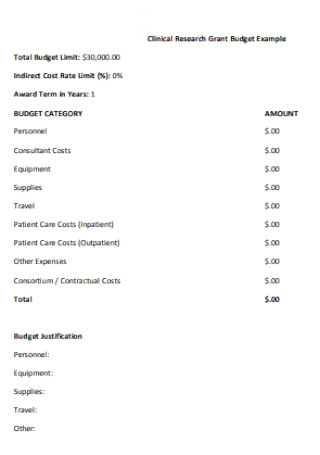
Clinic Research Grant Budget
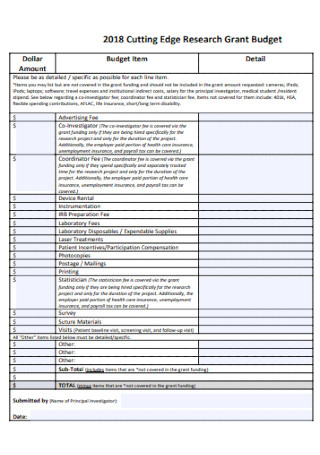
Research Grant Budget Template
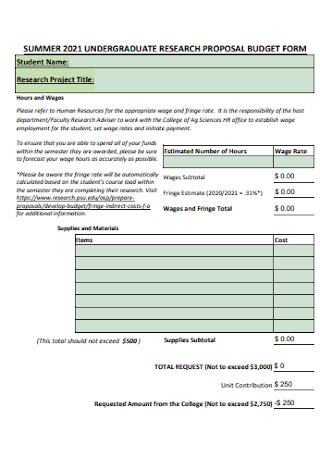
Undergraduate Research Budget Form
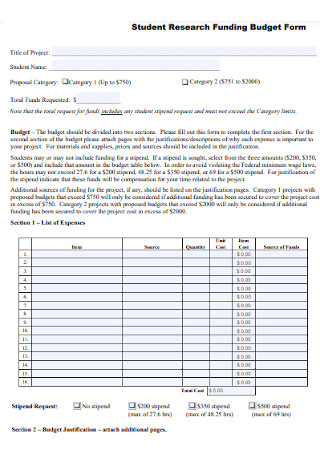
Student Research Funding Budget
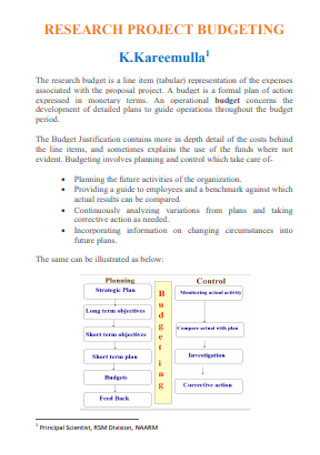
Research Project Budget Template
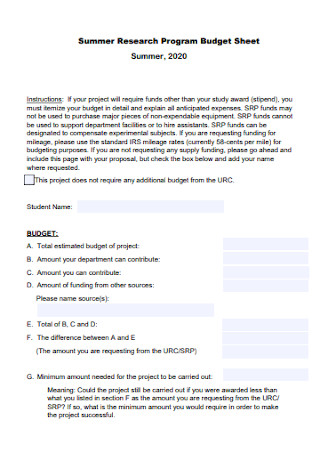
Research Program Budget Sheet

Film Research Budget Template
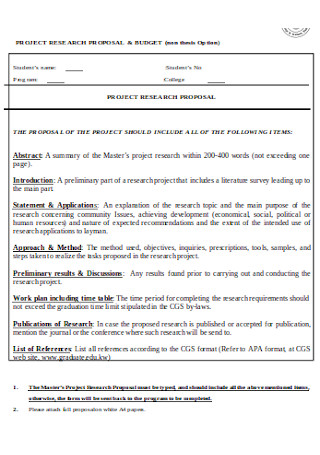
Project Research Proposal Budget
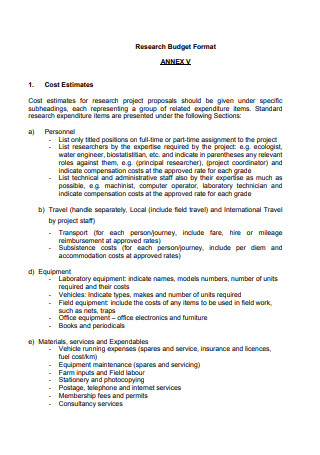
Research Budget Format
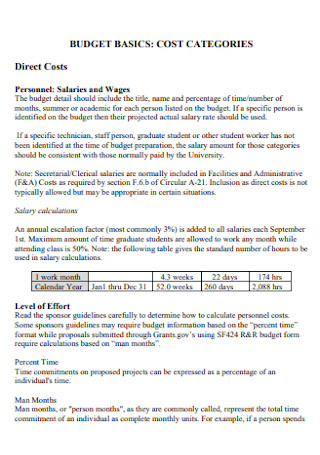
Basic Research Budget Template

Health Service Research Budget
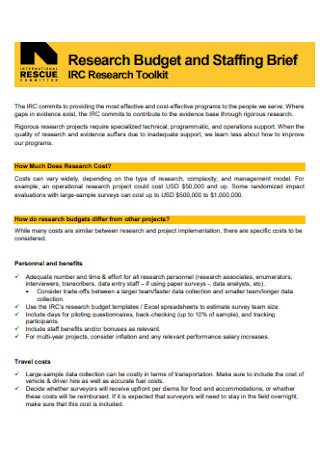
Staffing Research Budget
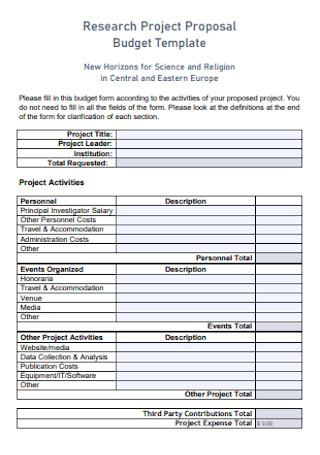
Simple Research Budget Template
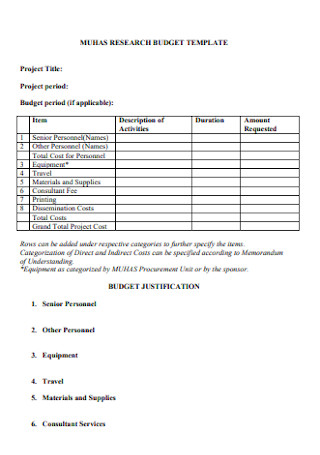
Formal Research Budget Template
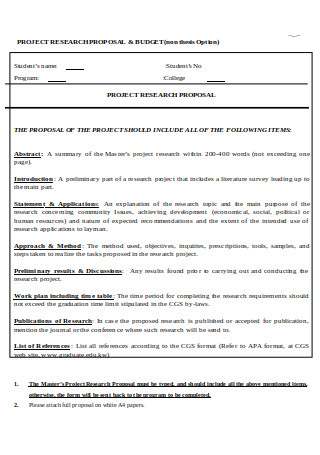
Research Proposal and Budget
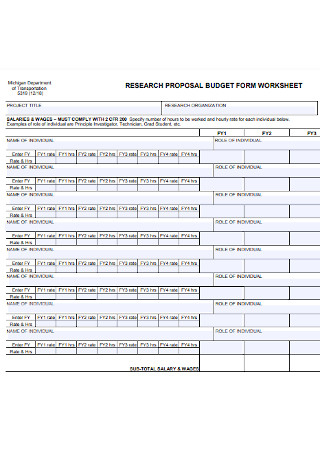
Research Budget Form Worksheet
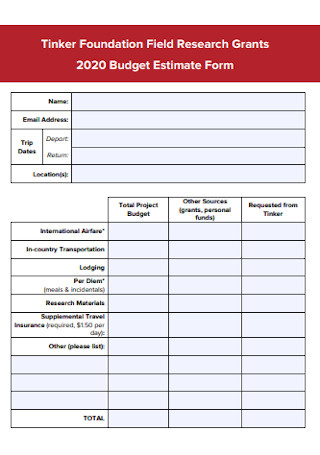
Foundation Field Research Budget
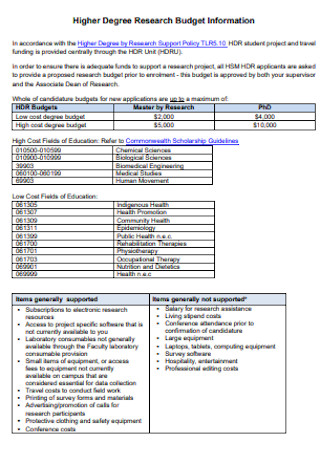
Higher Degree Research Budget
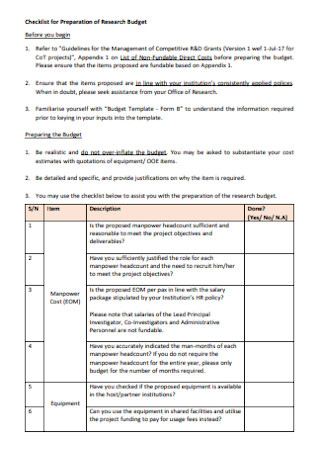
Checklist for Preparation of Research Budget
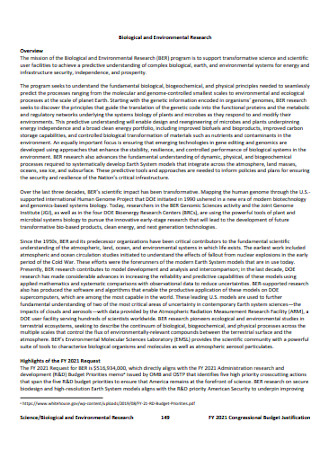
Biological and Environmental Research
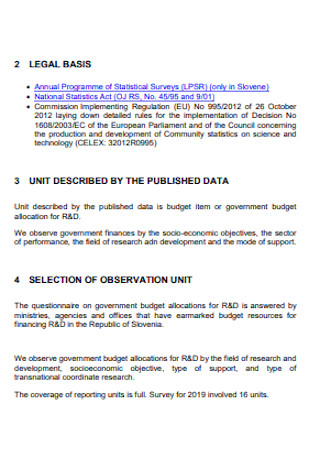
Governament Research Budget Template
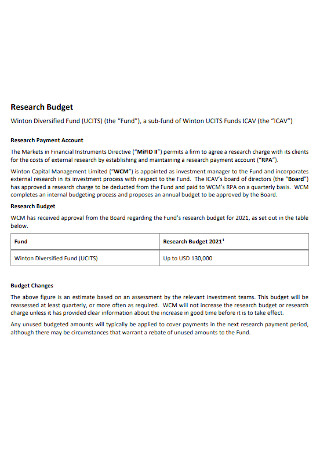
Research Payment Budget Template
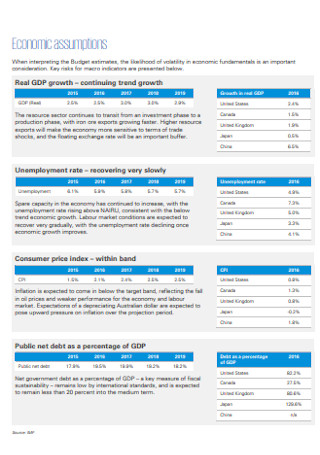
Standard Research Budget Template


Research Development Budget Template
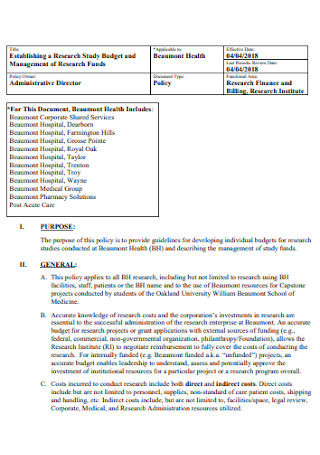
Research Study Budget
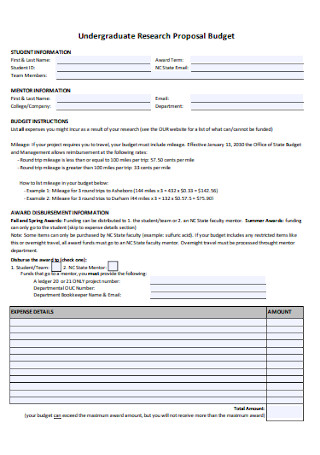
Undergraduate Research Proposal Budget
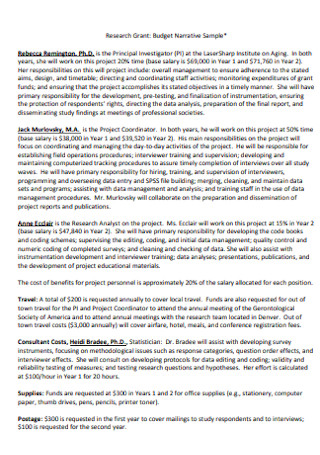
Sample Research Grant Budget
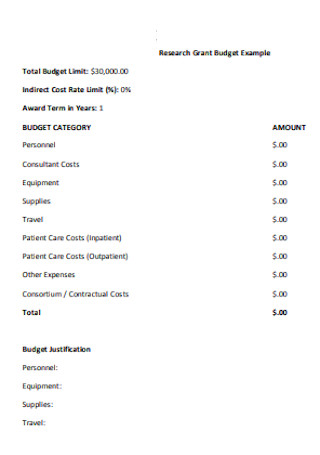
Research Grant Budget Example
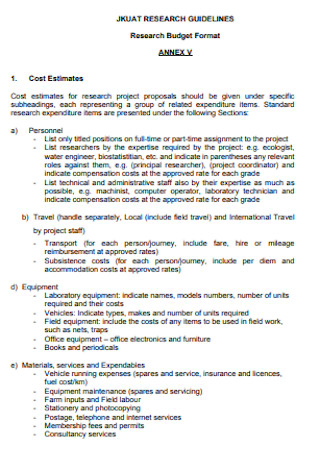
Survey Research Budget Template

Annual Research Budget Template
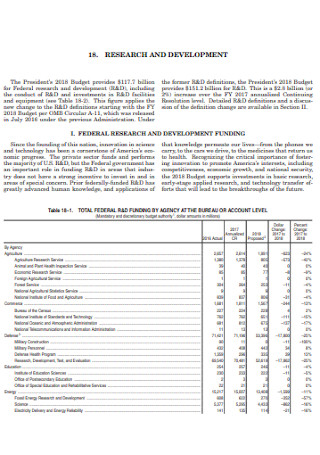
Research Development Budget Example
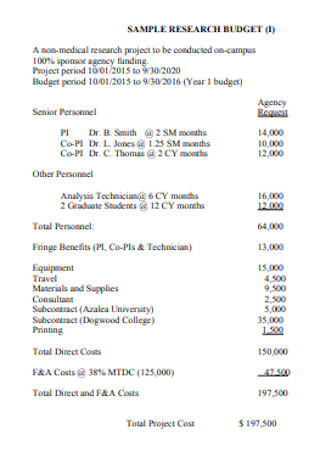
Sample Project Research Budget
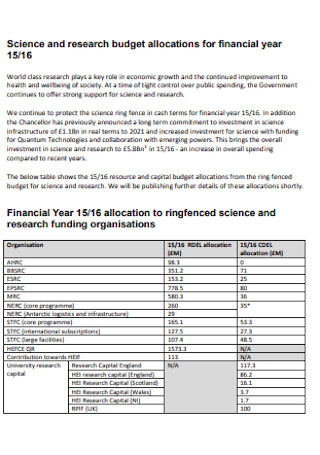
Science and Research Budget Template
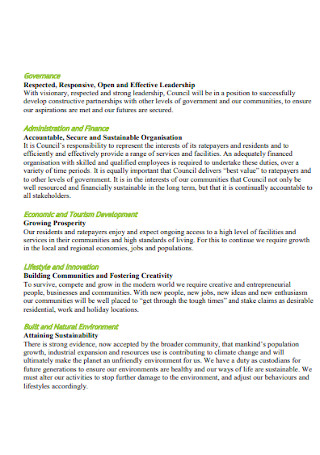
Annual Business Plan Budget
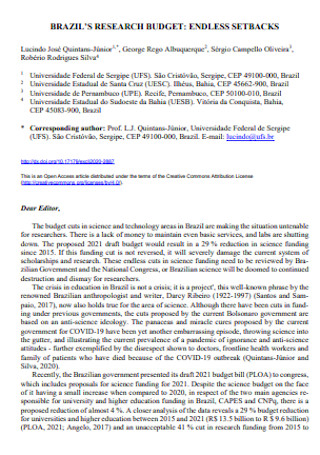
Formal Research Budget Example
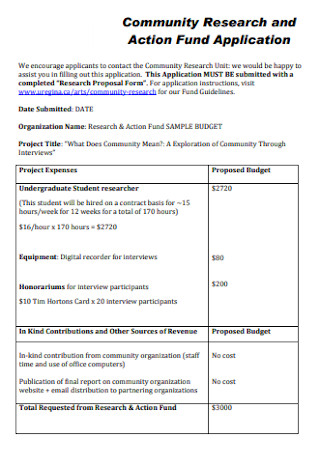
Community Research Budget Template
Why is a research budget important, step 1: brainstorm all research activities, step 2: consider the rules and regulations, step 3: insert the associated costs for each item, step 4: download a sample research budget, step 5: organize your data and format, step 6: justify your research budget.
- Incremental budgeting – this form of budgeting tackles a previous year’s actual figures while you add or subtract a percentage to answer the acquired budget of the current year. Also, this is the simplest and most common form of budgeting scheme.
- Activity-based budgeting – the next example focuses on getting the number of inputs necessary to provide the outputs and targets implemented by an organization. A common example is when a business should start recognizing the necessary tasks to take first that will meet the sales target until the costs for each activity to do will be determined.
- Value proposition budgeting – another budgeting scheme answers the reason for inputting the amount you estimated in a budget, how a value outweighs the expenses, or even why the budget should be justified. And as much as possible, do not include irrelevant expenditures in this section.
- Zero-based budgeting – lastly, this budgeting plan assumes that every department in a budget is zero and should be rebuilt from the very beginning. But, the expenses should be justified. And this strategy is helpful when you need costs quickly, particularly if a business undergoes an economic downturn.
Share This Post on Your Network
File formats, word templates, google docs templates, excel templates, powerpoint templates, google sheets templates, google slides templates, pdf templates, publisher templates, psd templates, indesign templates, illustrator templates, pages templates, keynote templates, numbers templates, outlook templates, you may also like these articles, 20+ sample hotel budget in pdf.
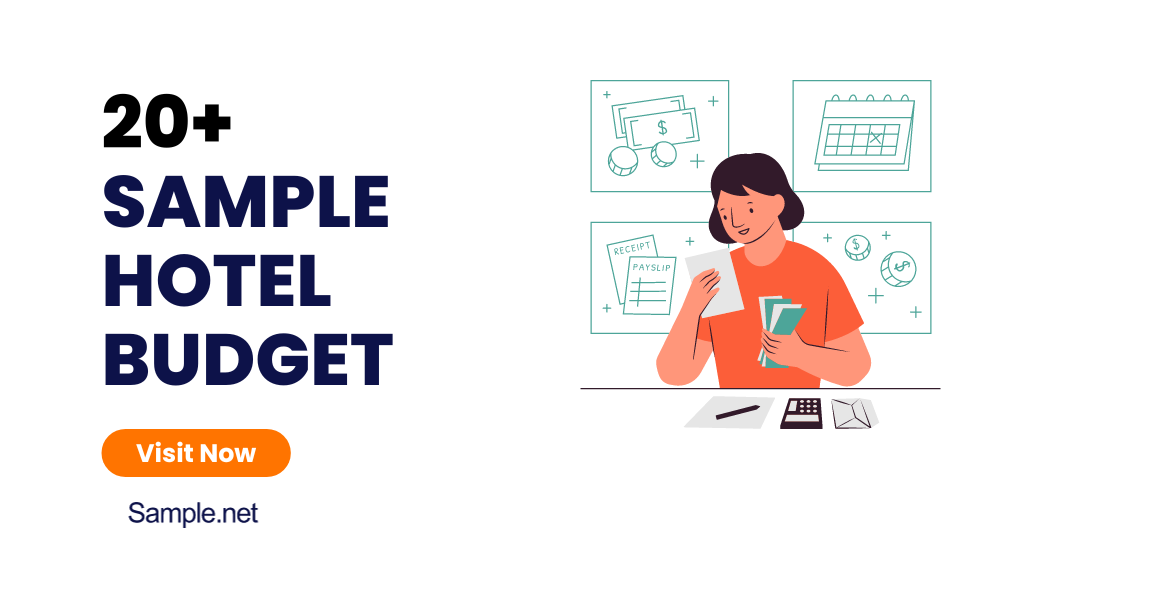
”A hotel should relieve travelers of their insecurity and loneliness. It should make them feel warm and cozy,” Bill Kimpton quotes. A hotel may have heavy expectations to satisfy…
50+ SAMPLE Library Budgets [ School, College, Public ]
![50+ SAMPLE Library Budgets [ School, College, Public ] sample library budgets](https://images.sample.net/wp-content/uploads/2022/01/SAMPLE-Library-Budgets.png)
A single book can introduce you to a million imaginations. You can only imagine how much knowledge, skills, and information a whole library has for book lovers. But just like…
browse by categories
- Questionnaire
- Description
- Reconciliation
- Certificate
- Spreadsheet
Information
- privacy policy
- Terms & Conditions
Newly Launched - World's Most Advanced AI Powered Platform to Generate Pitch Decks that are Editable in PowerPoint

Researched by Consultants from Top-Tier Management Companies

Powerpoint Templates
Icon Bundle
Kpi Dashboard
Professional
Business Plans
Swot Analysis
Gantt Chart
Business Proposal
Marketing Plan
Project Management
Business Case
Business Model
Cyber Security
Business PPT
Digital Marketing
Digital Transformation
Human Resources
Product Management
Artificial Intelligence
Company Profile
Acknowledgement PPT
PPT Presentation
Reports Brochures
One Page Pitch
Interview PPT
All Categories
Top 7 Research Budget Templates with Samples and Examples
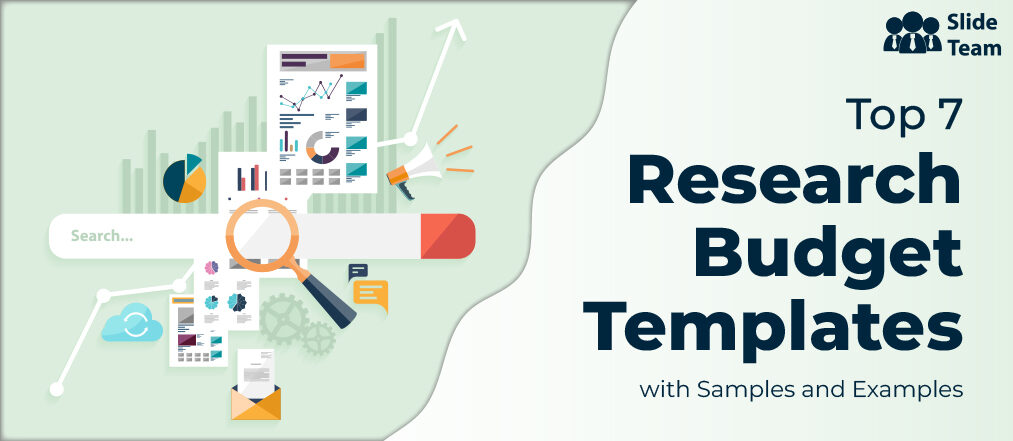
Tejas Prasanna
There is no magic formula for creating a research budget. Depending on the kind of research and the potential changes it can bring about, careful planning and allocation is necessary. Budgets can, thus, vary depending on the sponsors, besides other factors. However, every research budget has some essential guidelines.
Research budgets depend on the project deliverables, timelines, and milestones. The resources required also depend on the scope of the projects and sponsors.
Best Templates for Planning Your Research Budget
Designing a research budget is not easy. You will need to consider the resources required and categorize them according to guidelines to ensure funding is not a problem. The categories may include the project’s necessary supplies and equipment and the wages you must pay your assistants. Research budgets are allocated for a year, but you can also plan for a quarter, depending on the project.
At SlideTeam, we have taken care of all these pain points and designed content-ready presentation templates that address each of these points. You save the time, the resources, and the tedium in having to make these presentations from scratch.
What is even better is that each of the templates is 100% editable and customizable. The content-ready nature means you get a starting point and a structure to guide your presentation; the editability feature means you can customize the template to audience profile.
Let’s explore these templates now.
Template 1 - Impact matrix evaluation research solution budget
This PPT Template is the perfect solution for your research budgeting needs. The matrix suggests what solutions are essential with the help of relevant keys that assign priority levels. Priorities go from low to highest influence with increasing importance. They are color-coded, with white being the lowest and red being the highest influence. For instance, Maintain Awareness and Evaluation are red in many cases, as shown in the slide. So, that means that they bear a significant impact on the research budget. Similarly, Strategic and Budget Planning are color-coded white, which means they don't impact the research budget as much in some cases.
With the impact matrix and heatmap, mapping out your research budget will be a breeze.
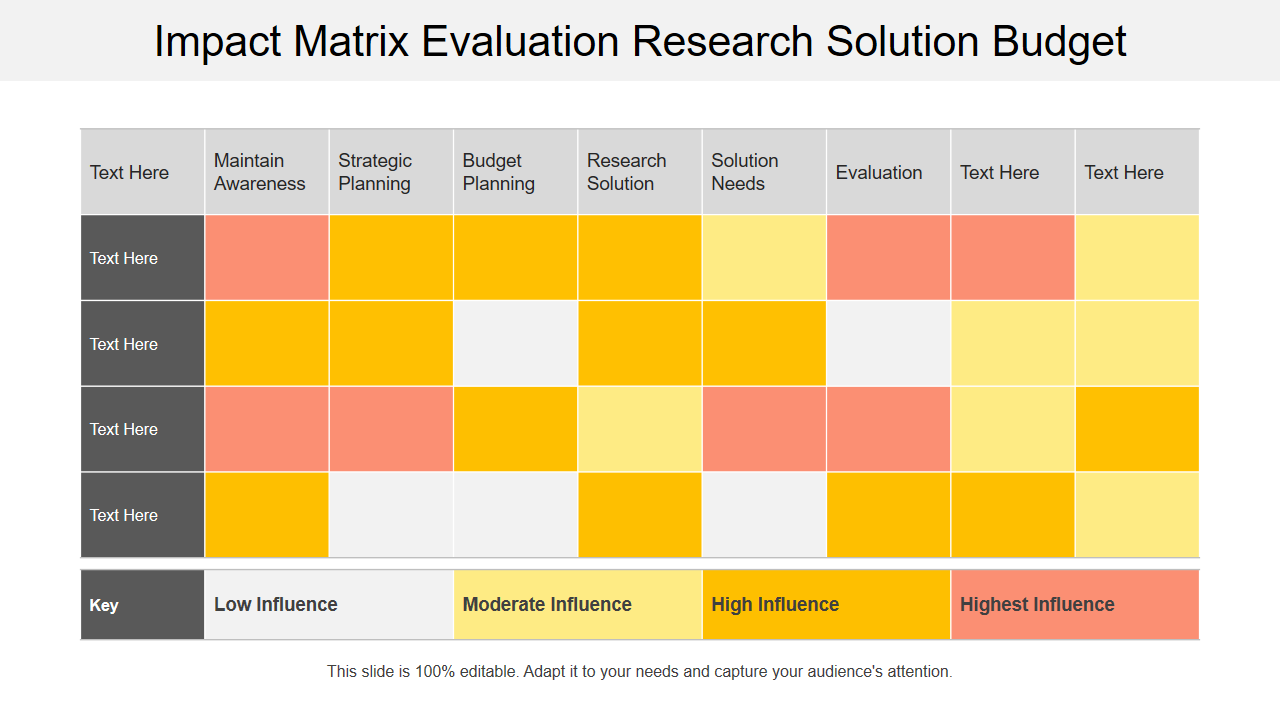
Get it now!
Template 2 Half-yearly research and development departmental budget
Research and Development departments can plan the budget required for projects for the two halves of the year using this PPT Template. The presentation template highlights areas for which you will need funding such as research and development, skills, innovation and patenting, and cooperation. You can also list your requirements for each area. For instance, under R&D and skills, you may need funding for medical research, chemical research, etc. Similarly, for innovation and patenting, you may need funding for product innovation and to cover patenting costs. Likewise, cooperation may involve setting up new laboratories and research centers. With this outlined, you can split the budget required for your research project for the two halves of the year.
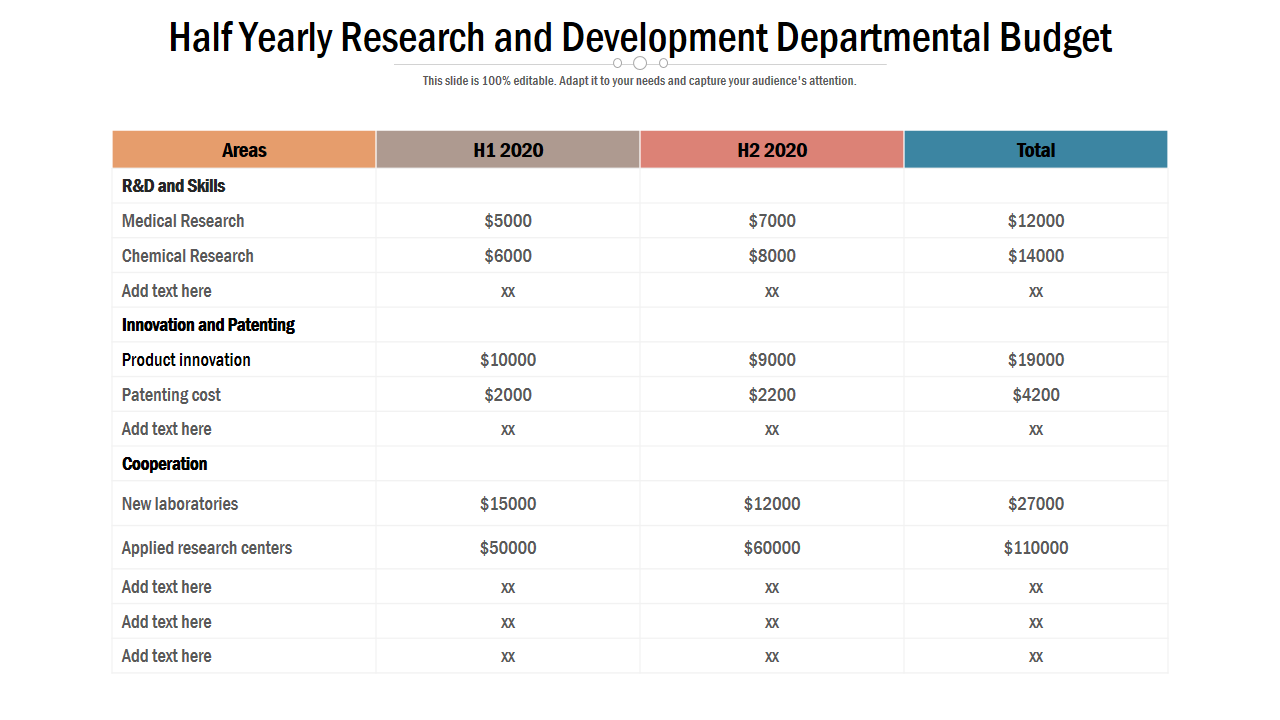
Download now!
Template 3 - Budget Estimate for Research and Development Project
This presentation template for the budget estimate for your research and development project is apt for arriving at the calculation for the four quarters in a year. You can define and assign tasks as per the requirements of the project and allocate a set budget for each. The tasks may involve conducting market research and competitive analysis or be innovative or developmental. In either case, you can use this template to set a fixed budget for each task in the research project.
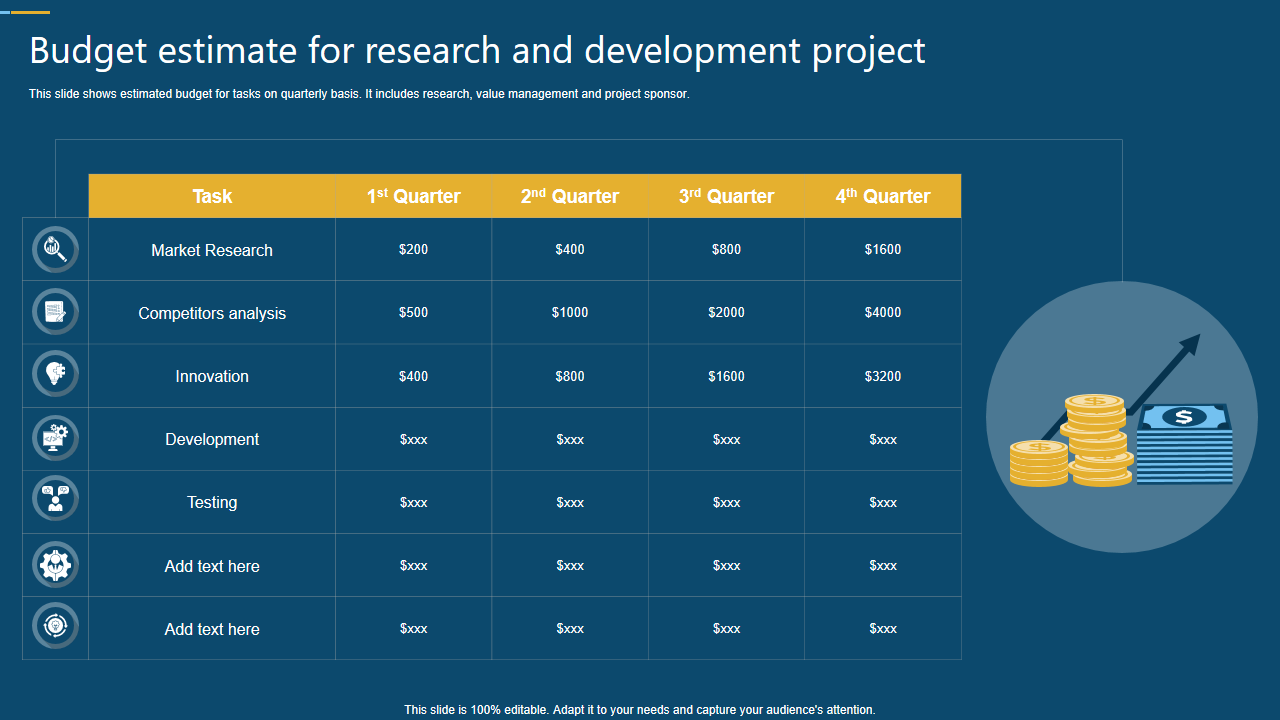
Get it today!
Template 4 Clinical Trial Phases with Communication and Budget Research Design for Clinical Trials
Clinical trials involve many phases, and you should let your research associates know about each step. For instance, you could post the information on the company website and provide relevant insights during the pre-trial phase. Similarly, you can offer the welcome letter and training materials during the trial start-up. During the trial, you can send newsletters to your associates, giving them relevant information and other valuable insights. All this requires funding, and you will need to allocate a budget. However, you don't need to worry, as this PPT Preset has you sorted, with dedicated sections for the pre-trial, trial start-up, during-trial, and trial-end phases. It also has communication, insights summary, and budget sections. You can use the budget section in the matrix to allot a budget for each trial phase and each section, including communication and insights.
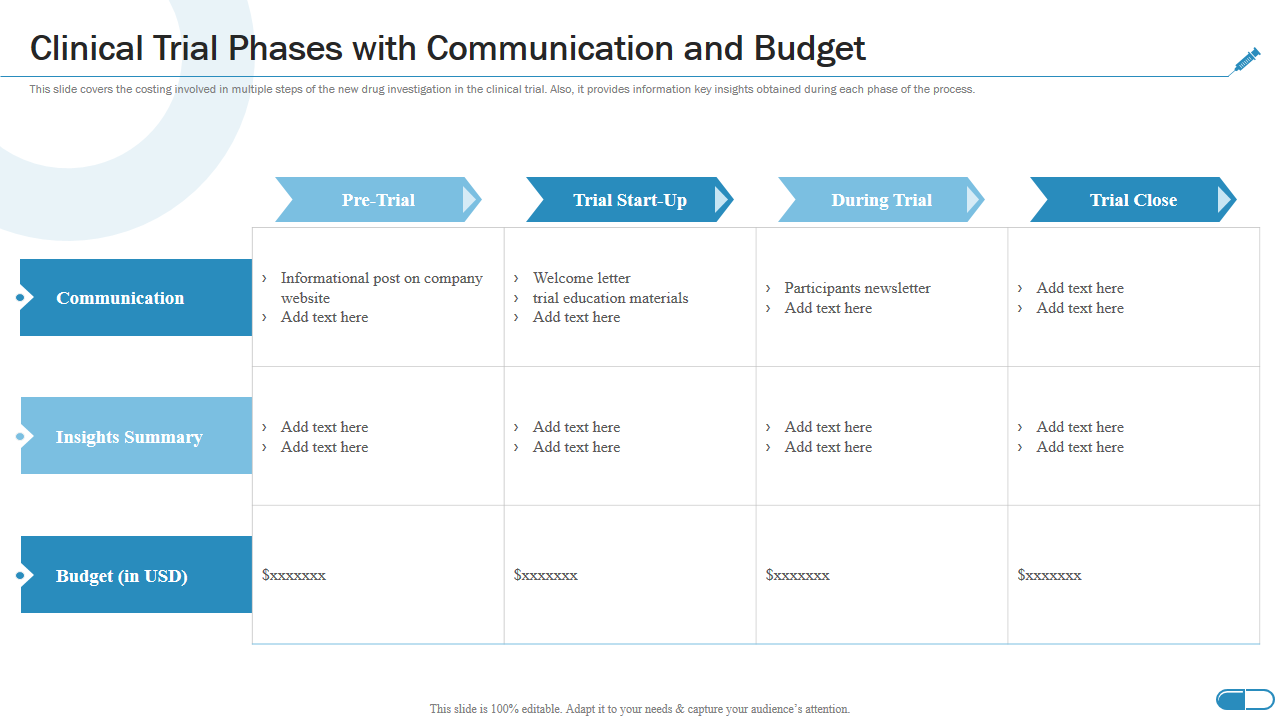
Download here!
Template 5 Market research strategy with budget and area
The PPT Template has all the core elements required for your market research strategy, including the budget and area. This slide lets you list your clients, the items, and when to send them. You can also list background information related to your research, the aim and objectives of the project, the areas covered, and the budget.
The presentation template also provides a dedicated space to list your brands and products and a timeline for completing the research.
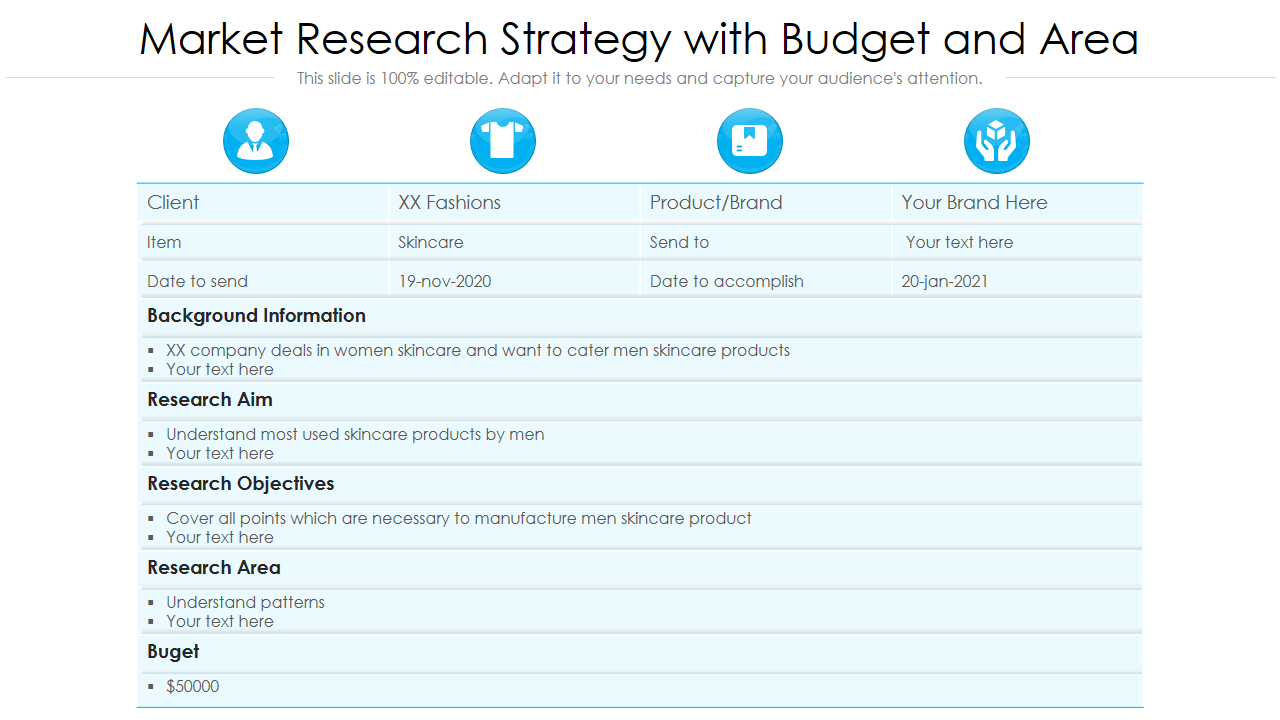
Template 6 - Determine Budget for Psychology Research Proposal One-Pager Sample Example Document
This presentation template is an easy-to-use tool for determining the budget required for psychology research. With this slide, you can allocate a budget for each area, including diagnostic assessment, training, technology and tools, supplies, travel, and workforce. It is a practical, hands-on template with information required to plan the budget for conducting psychological tests and evaluations. Please note that depending on your geography, taxes might or might not deserve a separate column.
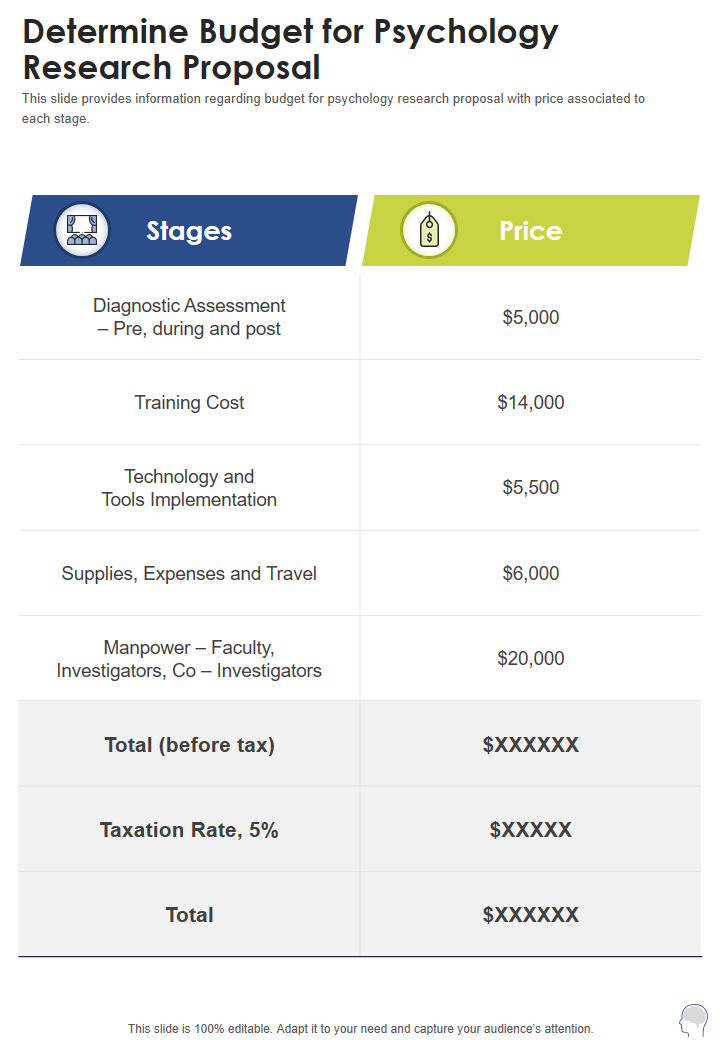
Template 7 - Budgeting for Product Launch Market Research
Every company needs to conduct market research before launching a new product. The PowerPoint Presentation that you have here can help you plan the budget required for conducting such market research. It includes necessary information, including business and research objectives, priorities, methodologies, and forecasts. The presentation template also has the metrics required for the research, such as improving customer engagement, introducing new products, and increasing market share. For example, to improve customer engagement, you may be looking to improve marketing approaches and gather customer feedback. The methods you may use include conducting marketing mix studies and tests. Similarly, you may want to optimize your social media posts and profiles and conduct A/B tests when introducing new products. Improving your market share may involve analyzing the competition. You may even use this handy template for conducting market research, estimating, and forecasting budgets.
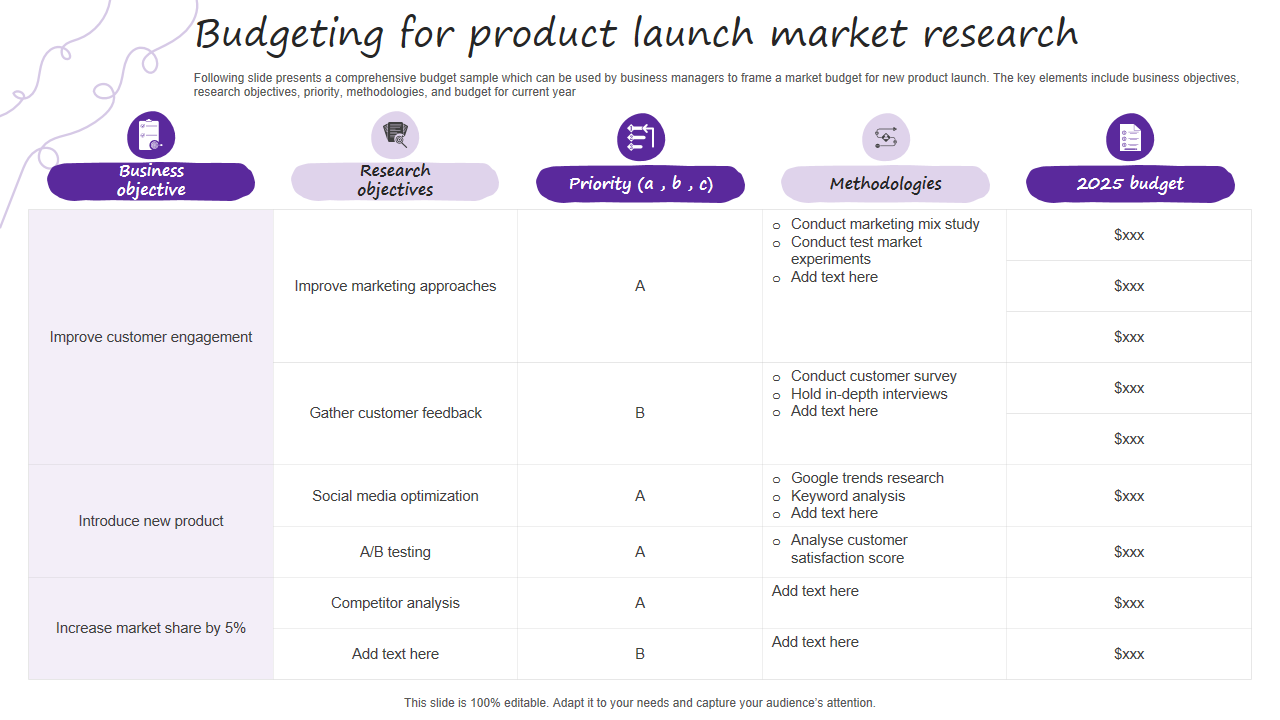
RESEARCH IS IMPORTANT BUSINESS
You can plan your research and the budget required using these templates. Remember that each new product launch has lots of research behind it. When going for a new launch, don’t just research the products and its uses, but also the markets – particularly, your target audience and how they will benefit from your brands. When allocating the budget for your research, don't forget to note your total resources and try to be as cost-effective as possible. You must consider the expected costs that you may incur and use these templates to work out a research budget that fits within your resources.
FAQs on Research Budget
What should be included in a research budget.
Research budgets should include all direct costs, and facilities and administrative costs (F&A). The facilities and administrative expenses are needed to achieve the primary objectives of the research. The project description should state the proposed budget and serve as a financial expression for the research. The idea is to ensure that the budget is comprehensive.
How do you create a research budget?
You can create a simple research budget by following these steps:
- List activities that will help you carry out the research.
- Check the rules for getting the funding required.
- Check all costs involved.
- Lay out the costs using a spreadsheet.
- Justify your budget by asking why and for what you need the money and where you got your figures.
What is the role of budget in research?
A budget can provide a detailed and clear picture of the structure of the research project, not to mention that it also lets you know how well it can be managed. The research project budget usually lets you see whether it will go according to plan and if it is feasible. So, it must be complete and reasonable.
What is the average budget for a research project?
The budget for a research project depends on the type of research and the proposed difference it could make to a field of study. For instance, the average budget for a market research project may vary between $20,000 and $50,000. Similarly, larger scientific research projects may cost millions or even billions of dollars, as in pharmaceuticals.
Related posts:
- Top 5 Startup Budget Templates with Samples and Examples
- Top 5 Construction Project Budget Templates With Examples And Samples
- Top 10 Cost Comparison Templates with Examples and Samples
- Top 5 Budget Planner Templates with Examples and Samples
Liked this blog? Please recommend us

Top 10 Purchasing Process Example Templates with Samples

Top 10 Banking Company Profile Templates for Crafting a Profile that Makes Money Talk!
This form is protected by reCAPTCHA - the Google Privacy Policy and Terms of Service apply.

Digital revolution powerpoint presentation slides

Sales funnel results presentation layouts
3d men joinning circular jigsaw puzzles ppt graphics icons

Business Strategic Planning Template For Organizations Powerpoint Presentation Slides

Future plan powerpoint template slide

Project Management Team Powerpoint Presentation Slides

Brand marketing powerpoint presentation slides

Launching a new service powerpoint presentation with slides go to market

Agenda powerpoint slide show

Four key metrics donut chart with percentage

Engineering and technology ppt inspiration example introduction continuous process improvement

Meet our team representing in circular format

All Formats
Budget Templates
10+ research budget templates – word, pdf, excel.
Any type of research cannot do away with the fact that it needs a budget . Exhaustive and intensive research procedures are done to arrive at certain conclusions or prove educated guesses. Creating a sample budget for research means allocating an amount of money for the different research materials that need fund support.
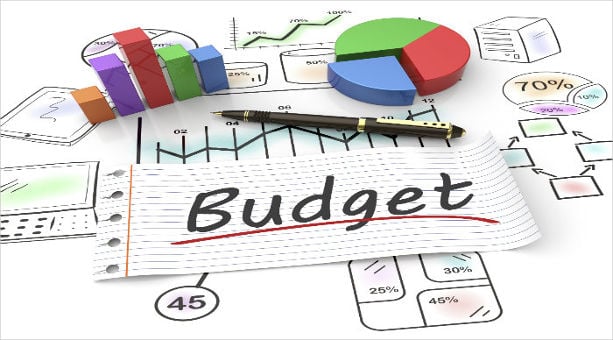
Research Budget Template
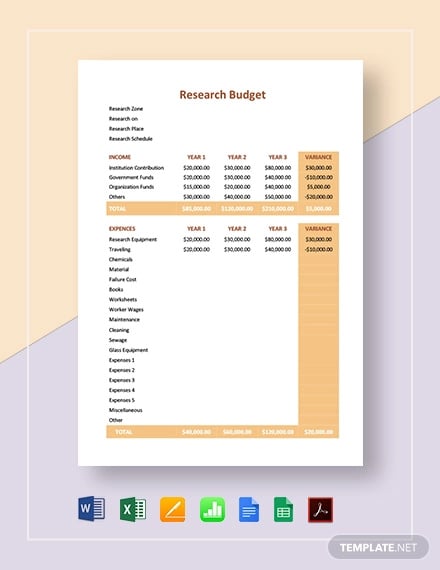
- Google Docs
- Google Sheets
- Editable PDF
Research Project Budget Template
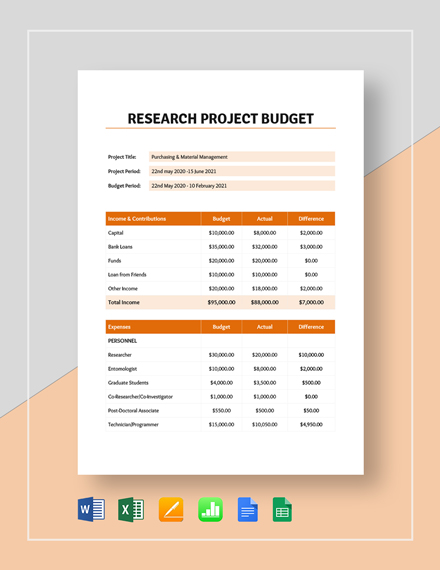
Research Budget Proposal Template
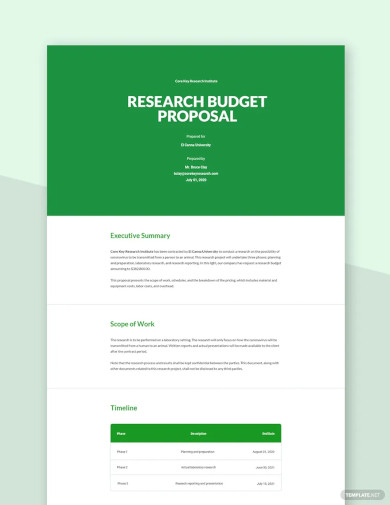
- Apple Pages
Free Medical Research Budget Template
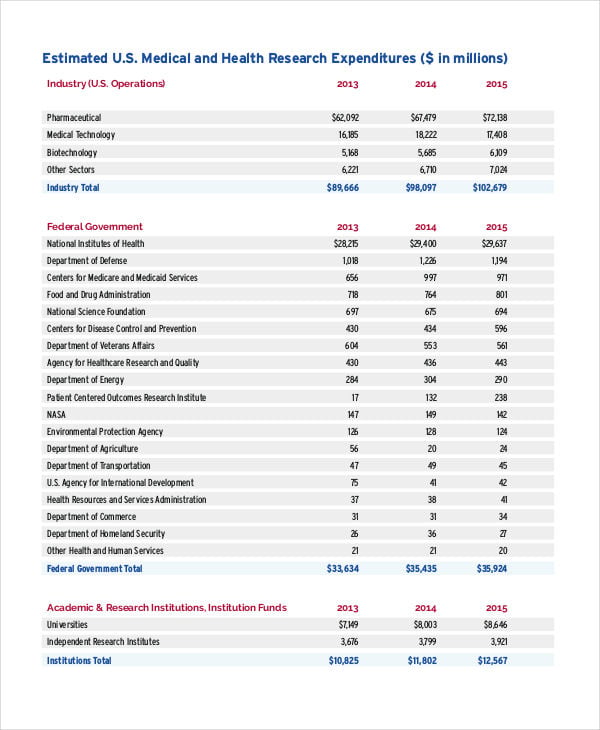
Free Research Proposal Budget Template

Free Budget for Research Development Template
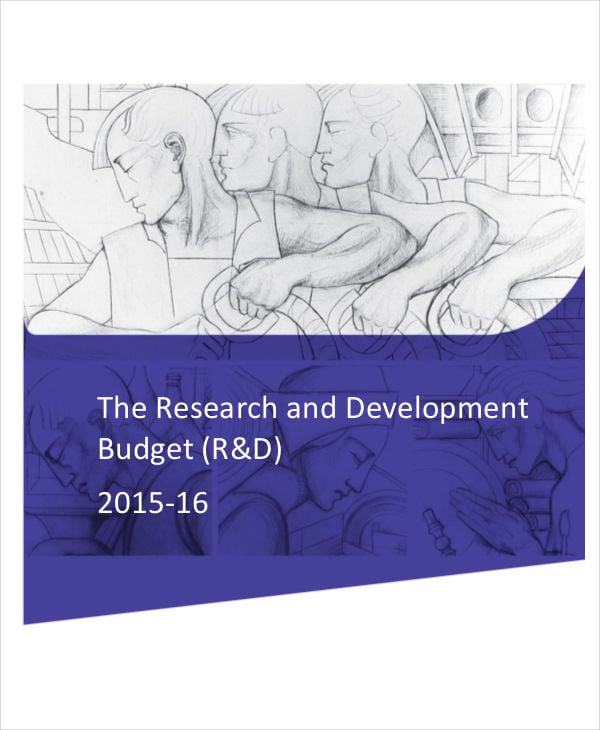
How to Make a Simple Research Budget
- List of Research Activities – Plotting a research budget outline could either be done before or after you’ve made a research draft or output. As you progress with your research, you would know the research activities that you need to fulfill for its completion. List all the prospective activities that you expect to do that’s covered by your research methodology.
- Activity Costing – Each item on your sample list should be provided with either an exact or approximate cost. Budget templates in PDF file format suggest that you provide space for the exact and estimated monetary value for each activity needed for your research. Grant budget samples are particular with activity costing to evaluate whether costs should be lowered or increased.
- Research Budget Template – It is important to secure a research budget template for all your research expenses. Film budget samples would tell you how important it is to keep track of how much money is spent and how much money left there is to spend. You can also see more templates like Project Budget .
Free Research Project Budget Template
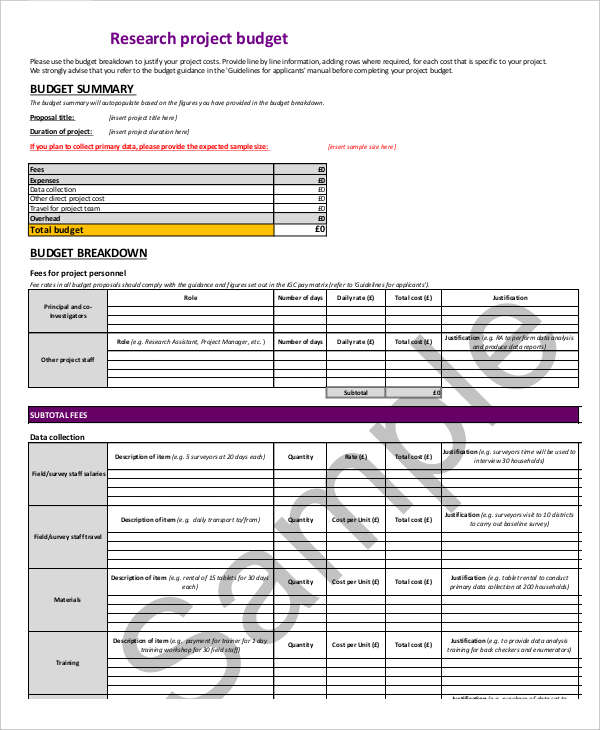
Free Research Grant Budget Template

Free Research Trip Budget Template
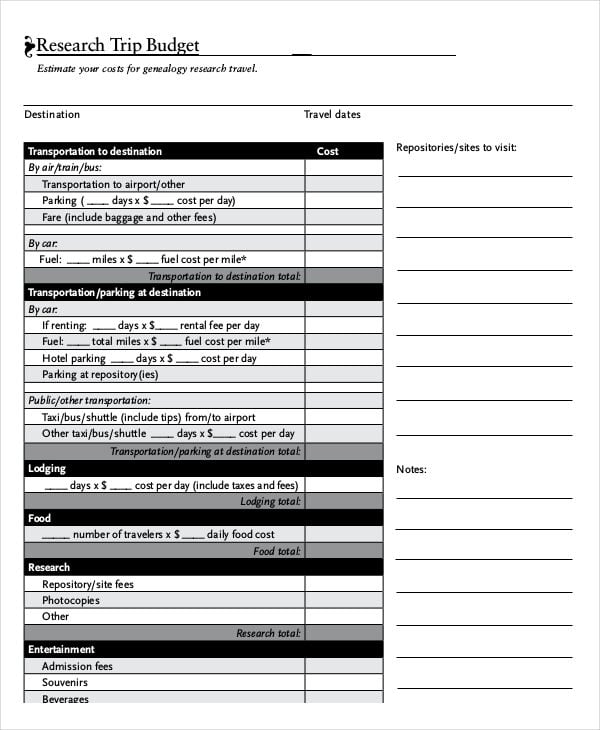
Free Sample Research Budget Template
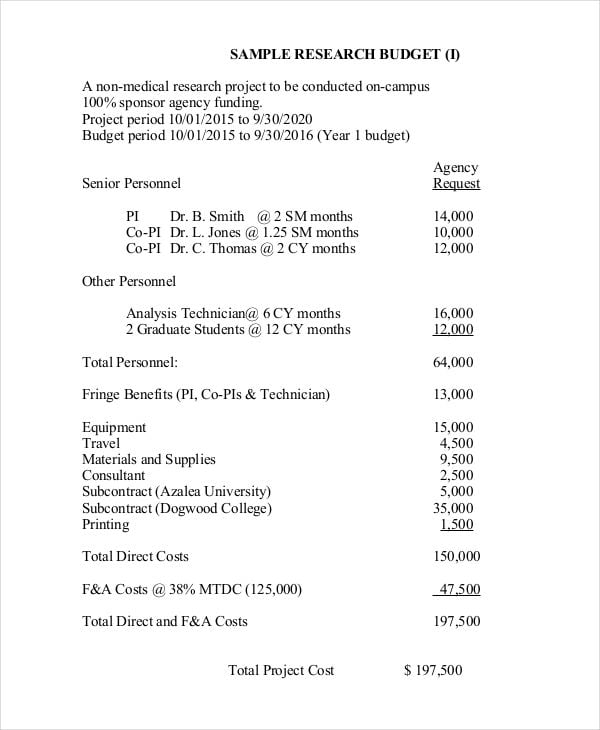
Common Expenses When Doing Research
- Tangible Materials – Anything that’s all used up when performing research procedures make up the most common expenses when doing so. Travel budget templates may focus on expenses that are the basic need while traveling. Some tangible materials might include food, medical kits, and other travel essentials.
- Printing Fees – Upon finalizing research work, researchers and target readers would need a hard and printed copy of a research paper. All budget report templates always make it to a point that printing fees should be the researcher’s priority upon completion of one’s research.
- Extended Research Services – Research activities always have the possibility of branching out to other services that may require specific expertise and mastery. Transcription services, for example, play a vital role in research completion and this type of service would undeniably be subject to extra expenses. Budget in Excel can be modified so that they specify what kind of research service is utilized.
General FAQs
1. what is the research budget, 2. why is a budget important, 3. what are the key factors of a budget.
- Plan out every penny with the help of a proper blueprint
- Know how much you earn
- Treat yourself once in a while
- Base yourself in reality and make the budget
- Be flexible with your expenses, so that you do not waste your funds.
4. What are Research expenses?
5. how to prepare a research budget.
- List out your activities
- Mention your goals and objectives
- Know all the rules and guidelines
- Plan out an action plan to reach your goals and objectives
- Put it all in writing
- Justify what your needs, resources, requirements, etc are.
More in Budget Templates
Editable research flowchart template, research poster template for keynote, education research agenda template, research agenda template, legal research methodology ppt template, medical research template, research template, qualitative research template, psychology research template, college research template.
- 5+ Budget Planner Templates
- 8+ Recruitment Budget Templates in MS Word | PDF
- 7+ Logistics Budget Templates in PDF
- 6+ Retirement Income Calculator Templates in XLS
- 10+ Retirement Budget Planner Templates in PDF | XLS
- 4+ Retirement Budget Spreadsheet Templates in DOC | XLS
- 15+ Sample Renovation Budget Templates – PDF, Docs
- 10+ Non Profit Budget Templates – Word, PDF, Excel
- 10+ Recurring Revenue Templates in Google Docs | Word | Excel | Numbers | Pages | PDF
- 10+ Cost Allocation Templates in Google Docs | Google Sheets | Excel | Word | Numbers | Pages | PDF
- 10+ Net Worth Summary Templates in Google Docs | Google Sheets | Excel | Word | Numbers | Pages | PDF
- 27+ Financial Projection Templates in Google Docs | Google Sheets | Excel | Word | Numbers | Pages | PDF
- 10+ Expense Allocation Templates in AI | Google Docs | Google Sheets | Excel | Word | Numbers | Pages | PDF | Publisher
- 10+ Operating Budget Templates in PDF | Google Docs | Google Sheets | Excel | Word | Numbers | Pages
- 10+ Employee Compensation Plan Templates in Google Docs | Google Sheets | Excel | Word | Numbers | Pages | PDF
File Formats
Word templates, google docs templates, excel templates, powerpoint templates, google sheets templates, google slides templates, pdf templates, publisher templates, psd templates, indesign templates, illustrator templates, pages templates, keynote templates, numbers templates, outlook templates.
- Log in / Register

- Getting started
- Criteria for a problem formulation
- Find who and what you are looking for
- Too broad, too narrow, or o.k.?
- Test your knowledge
- Lesson 5: Meeting your supervisor
- Getting started: summary
- Literature search
- Searching for articles
- Searching for Data
- Databases provided by your library
- Other useful search tools
- Free text, truncating and exact phrase
- Combining search terms – Boolean operators
- Keep track of your search strategies
- Problems finding your search terms?
- Different sources, different evaluations
- Extract by relevance
- Lesson 4: Obtaining literature
- Literature search: summary
- Research methods
- Combining qualitative and quantitative methods
- Collecting data
- Analysing data
- Strengths and limitations
- Explanatory, analytical and experimental studies
- The Nature of Secondary Data
- How to Conduct a Systematic Review
- Directional Policy Research
- Strategic Policy Research
- Operational Policy Research
- Conducting Research Evaluation
- Research Methods: Summary
- Project management
- Project budgeting
- Data management plan
- Quality Control
- Project control
- Project management: Summary
- Writing process
- Title page, abstract, foreword, abbreviations, table of contents
- Introduction, methods, results
- Discussion, conclusions, recomendations, references, appendices, layout
- Use citations correctly
- Use references correctly
- Bibliographic software
- Writing process – summary
- Sample research budget templat…
Sample research budget template
Download sample research budget template
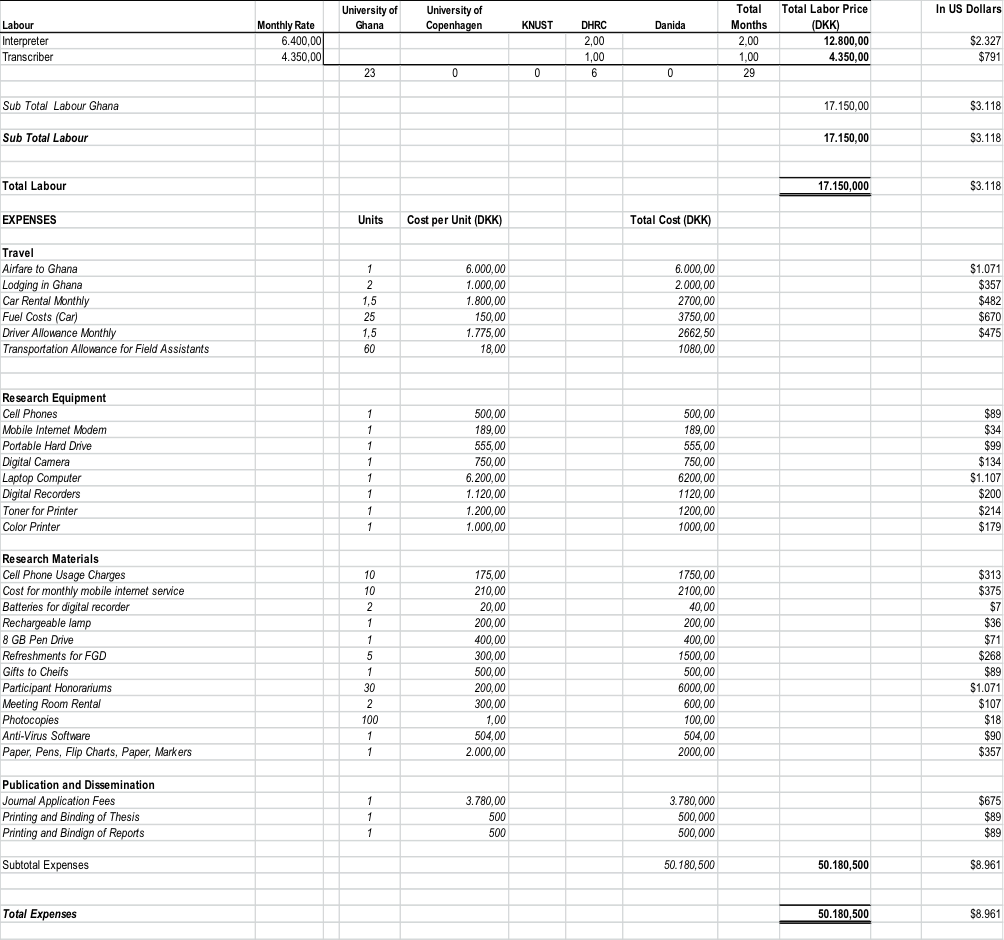
Your friend's e-mail
Message (Note: The link to the page is attached automtisk in the message to your friend)
- Share full article
Advertisement
Supported by
NASA Seeks ‘Hail Mary’ for Its Mars Rocks Return Mission
The agency will seek new ideas for its Mars Sample Return program, expected to be billions of dollars over budget and years behind schedule.

By Kenneth Chang
Kenneth Chang has reported on almost every NASA mission to Mars during the 21st century.
The cost of a proposed NASA mission to gather rocks on Mars and return them to Earth is spiraling upward and slipping further into the future. So on Monday, space agency officials asked for ideas on simplifying the mission and trimming its price tag.
“The bottom line is that $11 billion is too expensive,” Bill Nelson, the NASA administrator, said during a news conference on Monday. “And not returning samples until 2040 is unacceptably too long.”
The mission, known as Mars Sample Return, is central to the search for signs that life may have existed on the red planet. The idea is to bring samples of rock and soil back to Earth so that scientists can prod and poke at them using their most sophisticated tools.
NASA had hoped that Mars Sample Return would cost $5 billion to $7 billion, and that the rocks would arrive on Earth in 2033.
But last fall, a panel that reviewed the mission concluded that the cost was likely to be much higher, from $8 to $11 billion. NASA officials said on Monday that after they looked over the review, they agreed with that cost estimate, and that, given budget constraints, the current Mars Sample Return mission would not be able to deliver the rocks before 2040.
On Tuesday, NASA plans to issue a “request for information” seeking alternative plans from aerospace companies as well as experts within NASA, with proposals to be due on May 17. Of those, NASA would finance several of the proposals, with studies finishing later this year. Then NASA would have to decide its next step.
“We’re going to need to go off to some very innovative new possibilities for design and certainly leave no stone unturned,” said Nicola Fox, the associate administrator for NASA’s science mission directorate.
At the same time, she said she hoped for “traditional, tried-and-true architectures” that would reduce the risk of delay and failure.
“This is the Hail Mary,” Casey Dreier, the chief of space policy at the Planetary Society, a nonprofit organization that supports space exploration, said in an interview. Mr. Dreier said he had thought that NASA would simply announce a delay, which would reduce the amount it was spending on the mission in a given year, while adding to the final price tag.
“That would have been an easier way, from our perspective, to preserve the plan as it existed, to add certainty where there’s uncertainty,” Mr. Dreier said.
The first phase of Mars Sample Return is already underway. NASA’s Perseverance rover , which landed on Mars in 2021, has been drilling and collecting cylindrical samples of rock and soil in the Jezero Crater , which contains an ancient river delta.
The current Mars Sample Return plan, devised by NASA’s Jet Propulsion Laboratory in California, involves a complex choreography . First, a new robotic spacecraft would land near the Perseverance rover, which would then hand over about 30 of its rock samples. Those would then be launched into orbit around Mars. Yet another spacecraft, from the European Space Agency, would retrieve those samples, take them back to Earth and drop them off within a small disk-shaped vehicle that would land in a Utah desert.
To undertake a mission that would move more quickly and at a lower cost, one idea might be to leave some of the samples behind on Mars. That would reduce the size and complexity of the spacecraft needed.
If scientists were forced to choose which rocks they want most, “I think that will be some very, very lively and very exciting scientific chatter,” Dr. Fox said.
In February, Mr. Dreier wrote an essay about whether NASA could turn to Elon Musk’s SpaceX for a cheaper robotic Mars Sample Return mission. SpaceX’s mammoth Starship rocket is being designed with the goal of sending people to Mars .
“The answer is almost certainly ‘no,’” Mr. Dreier wrote then. “At least, not anytime soon.”
But if Mr. Musk and SpaceX are interested, NASA is now willing to listen. Mr. Dreier said that SpaceX would need to solve numerous technical challenges, including how it could produce propellants for the return trip.
“Is this getting to be less, or more expensive and time-consuming and risky than the original J.P.L. concept?” Mr. Dreier said, referring to the Jet Propulsion Laboratory’s plan.
SpaceX did not respond to a request for comment.
Mr. Dreier said that, as an optimist, perhaps Mr. Nelson was right and that someone would offer a better solution.
But he added that NASA’s announcement on Monday could be a pretext for canceling the mission, or trying to convince Congress that it indeed needed $11 billion.
“It may just be that people don’t want to accept that that’s what it costs,” he said. “I guess that’s one of the things we’ll find out.”
Kenneth Chang , a science reporter at The Times, covers NASA and the solar system, and research closer to Earth. More about Kenneth Chang
What’s Up in Space and Astronomy
Keep track of things going on in our solar system and all around the universe..
Never miss an eclipse, a meteor shower, a rocket launch or any other 2024 event that’s out of this world with our space and astronomy calendar .
Scientists may have discovered a major flaw in their understanding of dark energy, a mysterious cosmic force . That could be good news for the fate of the universe.
A new set of computer simulations, which take into account the effects of stars moving past our solar system, has effectively made it harder to predict Earth’s future and reconstruct its past.
Dante Lauretta, the planetary scientist who led the OSIRIS-REx mission to retrieve a handful of space dust , discusses his next final frontier.
A nova named T Coronae Borealis lit up the night about 80 years ago. Astronomers say it’s expected to put on another show in the coming months.
Is Pluto a planet? And what is a planet, anyway? Test your knowledge here .
Federal budget 2024 in 5 minutes-ish Insurance Inside Out
The podcast is intended for information purposes only. Neither Sun Life Assurance Company of Canada nor the hosts have been engaged for the purpose of providing legal, accounting, taxation, or other professional advice. No one should act upon the examples/information without a thorough examination of the legal/tax situation with their own professional advisors, after the facts of the specific case are considered. Unless specifically stated, the values and rates presented are not guaranteed. The information provided on the podcast is subject to change without notice and is not guaranteed to be correct, complete, current or up-to-date. All commentary is provided in good faith without legal responsibility.
- Episode Website
- More Episodes
- © Sun Life Assurance Company of Canada. All rights reserved.
Top Podcasts In Business
KPMG Personalization

2024 Federal budget highlights
Canada's Deputy Prime Minister and Finance Minister Chrystia Freeland delivered Canada's 2024 federal budget on April 16, 2024
- Share Share close
- Download 2024 Federal budget highlights pdf Opens in a new window
- 1000 Save this article to my library
- View Print friendly version of this article Opens in a new window
- Go to bottom of page
- Home ›
- Insights ›
The budget expects a deficit of $40.0 billion for 2023-24 and forecasts deficits of $39.8 billion for 2024-25, and $38.9 billion for 2025-26. Although the budget does not change the federal personal or corporate tax rates, Finance announced that it will increase the inclusion rate for capital gains realized on or after June 25, 2024, in certain circumstances. Specifically, the inclusion rate will increase to 2/3 for corporations and trusts and to 2/3 for individuals on the portion of capital gains realized in the year that exceed $250,000. Finance also provided details on related changes to increase the Lifetime Capital Gains Exemption to $1.25 million, and clarified a temporary tax exemption on up to $10 million in capital gains that may be realized when a business is sold to an Employee Ownership Trust (EOT).
One of the major themes of this year’s budget is to increase the affordability of housing. In particular, the budget provides several incentives for purpose-built rental housing in Canada, including an elective exemption from the interest deductibility limitation and enhanced Capital Cost Allowance (CCA) for certain new additions of property. There are also new measures intended to benefit first-time homebuyers. Finance’s budget also focuses on clean economy changes, including to provide expected detail on the Clean Electricity investment tax credit, among others.
Download this edition of the TaxNewsFlash to learn more.

How new measures announced in this year’s budget may impact Canadians and businesses

KPMG in Canada provides the latest Canadian tax news and international tax news for you and your business
KPMG in Canada provides the latest Canadian and international tax news for your business

Quick tax information for corporations and individuals
- Bureaus and Offices
- Contact HRSA
- Continuation Funding
- Apply for FY 2024 Behavioral Health Service Expansion
BHSE Sample Minor Alteration and Renovation Budget Justification
BHSE Location: Health Center Site, 123 Main Street, City, State, Zip Code
Total BHSE Minor A/R Funding Request: $100,000
Total Funding from Other Sources (State Grant and Private Contributions): $35,000
Total Project Cost: $135,000
For our minor A/R project, we propose converting an existing storage space and removing a wall to create a counseling space for mental health services. It will also include minor cosmetic work, including new tile flooring and new carpet in the counseling space. We will repaint the spaces, and replace the lighting with more energy efficient lighting throughout the 1,000 SF space.
In addition, we will purchase clinical and non-clinical equipment. We expect to begin renovation activities within 60 days of obtaining all local approvals. We expect to complete the work no more than 3 months after it begins.
Sample minor A/R budget justification
Sample allowable and unallowable costs.
The table lists sample allowable and unallowable costs for a proposed minor A/R project.
The total federal and non-federal cost of your minor A/R project must be less than $1,000,000, excluding the cost of moveable equipment.
Refer to the cost principles in 45 CFR Part 75 for details on allowable costs.
Fixed equipment includes items that require you to modify the facility for its satisfactory installation or removal. Include them in the construction contract: for example, ductwork, generators, fume hoods, sinks, fixed shelving, built-in sterilizers, built-in refrigerators, and wiring or cabling inside walls or above ceilings.
Moveable equipment is a non-expendable item with a useful life of more than one year and a unit cost of $5,000 (or equal to the applicant’s capitalization threshold) or more.

IMAGES
VIDEO
COMMENTS
Steps to Take to Create Your Budget. 1. Consult Your Adviser, Committee Members, and Funding Sources for Guidelines. The source or sources responsible for funding your dissertation research will likely have guidelines on what is and isn't a billable expense. Before defining your projected costs, check your funding organization's ...
A good budget shows the assessors that you have thought about your research in detail and, if it is done well, it can serve as a great, convincing overview of the project. Here are five steps to create a simple budget for your research project. 1. List your activities. Make a list of everything that you plan to do in the project, and who is ...
What is a Proposal Budget and why is it needed? Before we get started talking about all the pieces of a budget, let's make sure that we're on the same page about what a budget actually is. A budget is a financial proposal that reflects the work proposed. It outlines the expected project costs in detail, and should mirror the project description.
Costs for Project Budgets - Appendix C. The budget justification is one of the most important non-technical sections of the proposal, and it is often required by the sponsor. In this section, the Principal Investigator (PI) provides additional detail for expenses within each budget category and articulates the need for the items/expenses listed.
Sample Research project budget Please use the budget breakdown to justify your project costs. Provide line by line information, adding rows where required, for each cost that is specific to your project. We strongly advise that you refer to the budget guidance in the 'Guidelines for applicants' manual before completing your project budget.
The amount of time spent on analysis does get affected — and therefore, the client can appreciate which professional fees can and cannot get affected by sample size change. 2. Expenses
For example, you are developing a budget for a funding opportunity with an indirect cost rate of 25%. Your direct costs are $201,000 broken down by expense categories shown in the second column of the table below. The third and fourth colums present the two ways you can include the 25% overhead in your budget using the Price Model or the Cost ...
Appendix 2: Example Budget of €90,000 1-year project 14 Appendix 3: Example Budget of €550,000 4-year project 15. 1 | Page Introduction 7 Steps to Building a Research Budget is a short guide designed to take you through the basic stages of creating a research budget. This document was produced by a cross-team working group from the
A well-developed budget is accompanied by a budget explanation or narrative, also known as a budget justification. A complete and realistic budget justification demonstrates that your project is well conceived. It also tends to minimize the chances that sponsors will arbitrarily reduce or eliminate budget categories. Sponsors have a good idea of what a project should cost, and
The sample budget template was conceived and created by a team of department administrative managers and OSP staff with the goal of helping researchers and support staff develop sponsored project proposal budgets. For more information about developing budgets see the Overview of Costs for Project Budget page. 13. Process. Budget, Costs, and Rates.
Sample Budget Justifications. Sponsor requirements differ, and sample budget justifications should be seen only as a starting point. Guidelines for sponsor requirements are in the annotated budget justifications. Read the solicitation and the sponsor's proposal preparation guidelines for each proposal's requirements.
Craft a convincing dissertation or thesis research proposal. Write a clear, compelling introduction chapter. Undertake a thorough review of the existing research and write up a literature review. Undertake your own research. Present and interpret your findings. Draw a conclusion and discuss the implications.
1. A set of instructions and definitions for budgeting. 2. Budget narrative templates for use with proposals to federal and non-federal sponsors. 3. Proposals to NASA ROSES cannot contain any information regarding salaries, fringe benefits, indirect costs, or total costs. Provided below is a justification template for such proposals.
A budget is a financial proposal that reflects the work proposed. It outlines the expected project costs in detail and should mirror the project description. A budget is presented as a categorical list of anticipated project costs representing the researcher's best estimate of the funds needed to support the proposed work.
While a thesis proposal is often only 3-7 pages long, a prospectus for your dissertation is usually much longer, with more detailed analysis. Dissertation proposals can be up to 25-30 pages in length. Note Sometimes, a research schedule or detailed budget may be necessary if you are pursuing funding for your work. Dissertation prospectus examples
Misc. funding is for unexpected expenses. $60. Total. $987.94. I estimated shipping costs to the best of my knowledge. * Costs are estimated based on average costs of the material; final cost may be slightly different. View examples of budgets for undergraduate research proposals at the University of Nevada, Reno.
NIH Modular Budget Guidelines. The modular grant is an NIH effort to streamline the proposal submission process. It is intended to focus the attention of investigators, their institutions, peer reviewers and NIH staff on science rather than budget details. It applies to research grant applications requesting up to $250,000 per year in direct costs.
The cleanly-formatted Google Doc can be downloaded as a fully editable MS Word Document (DOCX format), so you can use it as-is or convert it to LaTeX. Download The Dissertation Template. Download Grad Coach's comprehensive dissertation and thesis template for free. Fully editable - includes detailed instructions and examples.
What Is a Research Budget? A research budget showcases the allocated expenses in research, and it is usually represented in tables or charts. Oftentimes, the research budget is discussed twice: (1) it is used to discuss the overall budget plan for a grant or research proposal in case an organization approves of funding the research budget, and (2) it displays the associated expenses involved ...
This presentation template is an easy-to-use tool for determining the budget required for psychology research. With this slide, you can allocate a budget for each area, including diagnostic assessment, training, technology and tools, supplies, travel, and workforce. It is a practical, hands-on template with information required to plan the ...
Here's a sample template you can use to help you budget your research project. Download this research project budget template instantly anytime, anywhere, at any device. Create a detailed statement outlining the estimated costs of the research and allot funds to important expenses. Check monthly budget templates for more. Save a lot of time and effort as you do not have to make a budget from ...
Medical Research Budget Template. researchamerica.org. Download. A research proposal budget sample is in many ways similar to the research budget sample, only that at this stage, it is still a proposal. This sample is often written in a linear or tabular format and it details all the expenses that are associated with the proposal project.
Sample research budget template. Download sample research budget template ...
NASA had hoped that Mars Sample Return would cost $5 billion to $7 billion, and that the rocks would arrive on Earth in 2033. But last fall, a panel that reviewed the mission concluded that the ...
Federal budget 2024 in 5 minutes-ish. Insurance Inside Out. The podcast is intended for information purposes only. Neither Sun Life Assurance Company of Canada nor the hosts have been engaged for the purpose of providing legal, accounting, taxation, or other professional advice. No one should act upon the examples/information without a thorough ...
The budget expects a deficit of $40.0 billion for 2023-24 and forecasts deficits of $39.8 billion for 2024-25, and $38.9 billion for 2025-26. Although the budget does not change the federal personal or corporate tax rates, Finance announced that it will increase the inclusion rate for capital gains realized on or after June 25, 2024, in certain circumstances.
3:28 Budget 2024 introduces capital gains tax changes that will impact 0.13 per cent of Canadians Editor's note: An earlier version of this story said Budget 2024 is proposing an increase in the ...
"Mars Sample Return will be one of the most complex missions NASA has ever undertaken. The bottom line is, an $11 billion budget is too expensive, and a 2040 return date is too far away ...
Sample allowable and unallowable costs. The table lists sample allowable and unallowable costs for a proposed minor A/R project. The total federal and non-federal cost of your minor A/R project must be less than $1,000,000, excluding the cost of moveable equipment. Refer to the cost principles in 45 CFR Part 75 for details on allowable costs.